Abstract
Bitcoin (BTC) is one of the most important cryptocurrencies widely used in various financial and commercial transactions due to the fluctuations in the price of this currency. Recent research in large data analytics and natural language processing has resulted in the development of automated techniques for assessing the sentiment in online communities, which has emerged as a crucial platform for users to express their thoughts and comments. Twitter, one of the most well-known social media platforms, provides many tweets about the BTC cryptocurrency. With this knowledge, we can apply deep learning (DL) to use these data to predict BTC price variations. The researchers are interested in studying and analyzing the reasons contributing to the BTC price’s erratic movement by analyzing Twitter sentiment. The main problem in this article is that no standard model with high accuracy can be relied upon in analyzing textual emotions, as it represents one of the factors affecting the rise and fall in the price of cryptocurrencies. This article aims to classify the sentiments of an expression into positive, negative, or neutral emotions. The methods that have been used are word embedding FastText model in addition to different DL methods that deal with time series, one-dimensional convolutional neural networks (CONV1D), long-short-term memory networks (LSTMs), recurrent neural networks, gated recurrent units, and a Bi-LSTM + CONV1D The main results revealed that the LSTM method, based on the DL technique, achieved the best results. The performance accuracy of the methods was 95.01, 95.95, 80.59, 95.82, and 95.67%, respectively. Thus, we conclude that the LSTM method achieved better results than other methods in analyzing the textual sentiment of BTC.
1 Introduction
Over the past few decades, individuals and businesses have used digital currencies at an astounding rate of growth [1]. Hence, these days, cryptocurrencies are an essential component of society. In order to implement a cryptocurrency system in place of the complete money exchange, it was initially released as Bitcoin (BTC) in 2008 [2]. This digital currency is based on blockchain technology and provided by Satoshi Nakamoto [3]. Due to its electronic and decentralized nature, BTC is not governed or controlled by any bank or government. Thanks to consistent media coverage and distribution, BTC has grown tremendously and attracted a sizable user base [4]. The web era has reshaped people’s attitudes toward their thoughts, so many companies have used social media networks to advertise their products or to take feedback from their customers. Social media platforms such as WhatsApp, LinkedIn, Twitter, Google Plus, and Instagram are just a few examples. People use these websites to express their opinions or points of view [5].
Twitter, a well-known social networking site, offers users a service that allows anyone to send and receive brief text messages. Twitter allows users to view one another’s posts even if they are strangers [6]. Investors commonly express their feelings on Twitter, making it a rich source of emotional intelligence and providing live updates on crypto-currency information [7]. An analysis by the American Institute of Economic Research found that news from around the world can cause significant variations in the price of BTC. Investigating how people feel about BTC via tweets is beneficial [8]. Data sentiments can be identified using deep learning (DL) technology [9].
The motivation behind this study stems from the absence of a precise and highly accurate model for analyzing emotional content in social media. This model is crucial in understanding the fluctuations in the value of encrypted currencies, which can greatly impact financial gains. Developing a robust strategy to effectively tackle this matter is of utmost importance for investors who invest in these encrypted currencies. DL techniques were employed due to their ability to yield favorable results across diverse research fields.
This article contributes to enhancing the understanding of those interested in the subject matter by examining DL methodologies and their efficacy in analyzing emotional expressions inside social media platforms. This analysis is particularly significant since it plays a pivotal role in determining the fluctuation of cryptocurrency prices. The study’s findings demonstrated that using DL approaches yielded better results than conventional machine learning methods. Moreover, these findings can assist investors interested in cryptocurrency trading by aiding them in selecting the most effective deep-learning model for analyzing textual sentiments sourced from social media and subsequently categorizing them as positive, negative, or neutral.
The following discusses current approaches that deal with this problem, the HyVADRF and Gray Wolf Enhancer (GWO) models. Semantic and rule-based Valence-Aware Dictionary and Sentiment Reasoner (VADER) were used for polarity scores and sentiment classification, while random forest was used for supervised classification. Recurrent neural networks (RNNs), long-short-term memory networks (LSTMs), and convolutional neural networks (CNNs) used DL architectures. Word2Vec, GloVe, and FastText were word embedding models [10,11].
Sentiment analysis (SA) is a technique for determining the polarity of people’s subjective opinions from straightforward writings written in everyday language. SA includes classifying comments in texts into “positive,” “negative,” or “neutral” categories [12]. Each sentiment is assigned a polarity, a floating-point number whose value lies between −1 and +1 based on polarity. We can define the sentiment of the statement. For positive emotion, the polarity is >0; for negative emotion, the polarity is <0; neutral sentiment is defined when the polarity is = 0 [13]. As a result, we propose using DL to improve the accuracy of SA.
This article focuses on classifying user emotion in BTC tweets using DL models such as LSTM, RNN, gated recurrent units (GRU), one-dimensional convolutional neural networks (CONV1D), and Bi-LSTM + Conv1D. From each tweet’s input word, using the FastText approach, the semantic word vectors are extracted from the lexical words. To train and forecast the emotion classification labels of the tweet into negative, positive, or neutral feelings. The experiment shows that the LSTM model gives more precise results in predicting sentiment classification accuracy.
The remaining seven sections of the article are as follows: Section 2 contains a review of the literature. Section 3 illustrates the background information. Section 4 introduces our proposed model. Section 5 contains the proposed model testing. Section 6 includes experimental results and discussion, and finally, Section 7 presents conclusions and future work.
2 Literature review
The study of text sentiment is one of the more popular natural language processing (NLP) research areas. Text SA has evolved from being initially a research issue in computer science to a cross-disciplinary research topic due to its significant relevance for society and business [14]. For sentiment classification, neural network-based techniques are used more frequently because they recognize distinct characteristics in data and establish broad context details. The invention of distributed representation has greatly enhanced sentiment categorization in neural networks [15]. This section covers the various taxonomy ways for examining the influences on various machine learning (ML) and DL architectures and how those techniques are improving to work in SA, as shown in Table 1.
Literature review for SA on BTC using ML and DL
| Ref | Year | Tech | Dataset size | Dataset source | Date range | Scraping tool | Word embedding feature extraction | Classifiers | Accuracy of sentiment classification | Limitations |
|---|---|---|---|---|---|---|---|---|---|---|
| [16] | 2022 | DL | 154,481 web articles 570,865 tweets 90,268 telegram posts | Tweet data | Between 2015 and 2021 | Twitter’s API | Sentiment extract using FinBERT | BERT | CryptoBERT for classification layer only 68% for full training 92% | Lack in accuracy and small dataset |
| CRYPTOBERT | ||||||||||
| [17] | 2022 | ML | 4 million tweets | Tweet data | From 2021-05-28 to 2021-09-25 | Twitter’s API | FinBERT, RNN, CNN, SVM, NB, Majority | FinBERT 83.52% | Lack in accuracy | |
| DL | Voting, LR, RF, Attention-LSTM and FCDNN. | |||||||||
| [10] | 2022 | ML | Total of 3,625,091 tweets | Tweet data | between Jan 1, 2021 and Dec 31, 2021 | Twitter’s API | TF_IDF | RF-GWO | RF-GWO and RF-Tune Ranger slightly outperformed the single RF model | Not applied advanced methods |
| RF-Tune Ranger | ||||||||||
| RF | ||||||||||
| [18] | 2022 | DL | Total of 40,000 tweets | Tweet data | From Jul to Aug 2021. | Twitter’s API | word2vec | LSTM, GRU and LSTM-GRU SVM, LR, GNB, ETC, DT and KNN | SA LSTM-GRU Is the best with BoW | Small dataset |
| BoW | ||||||||||
| ML | TF-IDF | |||||||||
| [3] | 2021 | ML | Total of 846,790 tweets | Tweet data | From Sep 2016 to May 2021 | Twitter’s API | Tweets are Manually labeled | BERT | RF 77% | Lack in accuracy, not applied advanced methods, and small dataset |
| RF | ||||||||||
| [19] | 2021 | DL | Cryptocurrency tweets from Weibo is 24,000, as well as 70,000 comments | Sina-Weibo | From the most recent 8 days | Tweets are manually labeled | The proposed approach develop (LSTM) based sentiment analyzer, compared the proposed approach with the (AR) approach | The proposed approach outperforms the (AR) by 18.5% in precision and 15.4% in recall | Small dataset | |
| [11] | 2020 | DL | 17,692 tweets. 7,372 from individual accounts and 10,257 from organizations | Tweet data | Between 05/01/2019 and 08/01/2019 | Twitter’s API | TextBlob that uses naive Bayes classifier | CNN, RNN, LSTM, Word2Vec, GloVe, and FastText | TextBlob 82.5% | Lack in accuracy and small dataset |
| [20] | 2020 | DL | 25,746 tweets | Tweet data | From Jan 1 to May 31, 2018 | Open source Java software tool | VADER | CNN, LSTM, NB, and SVM. | CNN-LSTM 88.7%. | Lack in accuracy and small dataset |
| GloVe | The proposed model CNN-LSTM | |||||||||
| [21] | 2018 | ML | Total of 7454 of which are positive, negative and neutral | BitcoinNews(@BTCTN), CryptoCurrency(@cryptocurrency), CryptoYoda(@CryptoYoda1338), CoinDesk (@coindesk) | From Jan 1 of 2015 to Dec 31 of 2017 | Word2Vector | Voting classifier consists of NB, Linear Support Vector and RF | Voting Classifier with Bag-of-words was 81.39% | Lack in accuracy, not applied Advanced methods and small dataset | |
| Bow |
Numerous research conducted in several disciplines have examined the subject of textual sentiment analysis. Onan [22] proposed graph-based neural network and evolutionary algorithm text improvement. GTR-GA creates diverse and high-quality augmented text data by exploring text data’s high-dimensional feature space using graph-based neural networks and genetic algorithms. HetGAPN, a graph attention network (GAT) model, technique is used to learn heterogeneous text data graph node representations. HetGAPN should use node aggregation and bidirectional attention to collect text data feature linkages. Then, genetically generate candidate embeddings to examine various input space locations. We evaluate candidate embeddings’ increased text data quality using perplexity. Most promising embeddings are used as parents, then crossover and mutation create new ones. Our findings show that GTR-GA creates high-quality, improved text data for downstream NLP applications, including SA and text classification. Onan [23] proposed SRL–ACO, a novel text augmentation system, that adds NLP model training data using SRL and ACO. SRL identifies word semantic responsibilities in a sentence, and ACO creates sentences that sustain them. SRL–ACO automatically creates data for NLP model accuracy. SRL–ACO boosts NLP classifier performance. SRL–ACO is shown to increase machine-learning model training NLP data quality and quantity. Onan [24] proposed a hierarchical graph-based text classification system that captures complicated node interactions and enhances text categorization using contextual node embedding and BERT-based dynamic fusion: the LFE parses text for part-of-speech tags, dependencies, and named entities. Domain-specific hierarchical graphs monitor node relationships. Then, contextual node embedding vectors describe hierarchical network nodes’ local, linguistic, and domain contexts. Graph CNNs understand graph structure and nodes in multi-level graph learning. Then, dynamic text sequential feature interaction translates sequential text into node features. Also, at this stage, attention-based network earning gathers node data. Dynamic fusion with BERT, At the last, completes text vector representation by fusing output from the previous stages with a pre-trained BERT model. Integrating BERT improves categorization. The system outperformed top classification algorithms on benchmark datasets. In [25], using two bidirectional LSTM and GRU layers, a bidirectional convolutional RNN architecture infers past and future contexts from two hidden layers with opposing orientations to the same context. For better bidirectional layers, group-wise augmentation identifies characteristics and strengthens key ones while weakening less significant ones. Feature space dimensionality is reduced, and high-level information is captured via convolution and pooling layers. Bidirectional convolutional RNN architecture with group-wise augmentation outperforms other SA algorithms in trials. Onan [26] proposed ensemble learning and DL-based sentiment classification with great massive open online course (MOOC) review prediction. About 66,000 MOOC assessments were evaluated using machine, ensemble, and DL. DL outperforms ensemble and supervised learning for educational data mining SA. GloVe word-embedding scheme-based representation and LSTM networks perform best in all conditions with 95.80% classification accuracy. Onan and Toçoğlu [27] identified sarcasm in social media data using neural language models and deep neural networks. Trigram-based inverse gravity moment-based term weighted word embedding represents text. Maintaining word order emphasizes key keywords. A three-layer stacked bidirectional LSTM architecture recognized humorous text. The approach was tested on three sarcastic corpora. Three neural language models (word2vec, fastText, and GloVe), two unsupervised term weighting functions (term-frequency and TF-IDF), and eight supervised term weighting functions were utilized in the empirical study, and the model’s 95.30% sarcasm categorization accuracy is promising.
3 Background
In this section, we will review a set of concepts.
3.1 SA
SA, also known as polarity classification, affect analysis, subjectivity analysis, sentiment classification, and opinion mining, includes several disciplines such as computational linguistics, NLP, information retrieval, ML, and artificial intelligence (AI). It analyses how people feel and think about goods, services, and events [28].
Every tweet has a sentiment, whether it is positive, negative, or neutral. The “sentiment score,” generated based on the positive and negative words in a tweet, can be used to determine the user’s sentiment. It is shown in the following equation:
Accordingly, P and N represent a tweet’s count of positive and negative words. Express the sentiment score distinctly as a discrete, two-valued variable called S that reflects the sentiment class (
The variable S records all sentiment score values as well as their variations. Sometimes, the textual data’s polarity value cannot discern the sentimentality’s level because the sentiment score can occasionally be 0, meaning that the positive and negative sentiment values have canceled each other out.
The zero emotion score produces erroneous data even though the text in the tweet is either positive or negative and not neutral. Therefore, to distinguish between them, the following constraints should be followed [29]:
3.2 SA using VADER
The Lexicon and Rule-Based Sentiment Calculation Valence-Aware Dictionary and Sentiment Reasoner (VADER)-based sentiment calculation was used in this study. VADER is an SA tool attuned to social media sentiments and based on vocabulary and rules. That is responsive to emotions’ positive, negative, and neutral polarities. VADER is available in the Natural Language Toolkit package (NLTK; http://nltk.org) [30]. The primary benefit of it is that it can apply to text data that has yet to be labeled. The model generates a lexicon that includes the positive, neutral, and negative sentiments and the scores for each. These scores are determined using polarity, so a number less than 0 indicates a negative sentiment. If the polarity is greater than 0, then the sentiment is positive. The sentiment will be neutral when the score is 0. By averaging out all the sentiment scores, using a pooling technique to assess the sentiment of tweets, known as the compound score, a different score that VADER has returned [31].
3.3 Word embedding
Word embedding techniques use artificial neural network (ANN) architectures to transform texts into a low-dimensional density matrix of actual values. Word embedding techniques are used to extract lexical and pragmatic contexts from massive amounts of text data [6,32]. Many word embedding methods exist, including GloVe, word2vec, FastText, etc. [33]. The Facebook research team provided the FastText method, a word representation library, in 2016 [34]. It has 600 billion word vectors and 2 m popular crawl words in 300 dimensions. It uses single words and hand-crafted n-grams as features because the simple architecture makes text classification incredibly effective and efficient. It employs morphological features to identify challenging words, and this capability enhances its generalizability. Utilizing n-grams, FastText word embedding creates vectors that aid in handling unknown words [35].
3.4 DL methods used for twitter SA
The structure and design of ANNs serve as the foundation for the techniques used in DL, a branch of ML. For Twitter SA in this work, five DL algorithms were used. Simple RNN, LSTM, GRU, BiLSTM, and 1D CNN algorithm.
3.4.1 RNN
The human brain manner processes information and serves as the inspiration for ANNs. Neurons created artificially comprise the neural network, whose architecture defines its characteristics. An RNN differs from traditional neural networks in that it has feedback loops throughout the network. As a result, it is applicable whenever the context of the input influences the accuracy of a prediction. The limited memory of a neural network is a consequence of the recurrent nature of the layers in the RNN, wherein the current state of each neuron is influenced by its prior state. The RNN can process sequential data, where both the input and output networks may consist of sequences of various lengths that are processed progressively via each cell [36]. The RNN architecture includes a singular-layer recurrent module incorporating a hyperbolic tangent (tanh) squashing function. This module consists of an input neuron, denoted as Xt, an unobservable output state, represented as ht, and the preceding unobservable output state, denoted as ht − 1. The weighted matrix, denoted as W, and the result, denoted as Yt [37].
3.4.2 LSTM
LSTM networks are a kind of RNN that can effectively capture and learn long-term relationships in sequential data. The networks were proposed by Hochreiter and Schmid Huber [1,38]. The potential for inaccurate predictions by the RNN model arises when the prior state lacks recentness, hence exerting an influence on the present state [39]. The LSTM model operates sequentially, processing input from the left to the right to effectively preserve and store knowledge over extended periods. This approach serves to mitigate the issue of vanishing gradient descent often seen in RNNs. The input, forget, and output gates are three interconnected layers inside the LSTM model, which regulate the data flow necessary for predicting the network’s output [40,41].
Input gate: Upon importing data, the information will first pass through the input gate. The switch determines the decision to store the information, which is contingent upon the state of the cell.
Output gate: The quantity of information that is produced is determined.
Forget gate: Responsible for determining whether to retain or discard the acquired information [42,43].
3.4.3 GRU
Another type of RNN that addresses the issue of vanishing gradients and optimizes the structure of the LSTM model is the GRU. GRUs effectively resolve both problems by consolidating the three gated units into two gated units: the update gate and the reset gate [44]. The two gates can communicate values to the network’s succeeding stages while storing relevant information in the memory cell. When evaluating performance in various testing scenarios, it has been shown that the GRU and LSTM may be equivalent [8,45].
3.4.4 BiLSTM
The Bi-LSTM model can extract contextual information from feature sequences by considering both forward and backward dependencies. The Bi-LSTM architecture allows for anticipatory processing by using a forward LSTM, which chronologically operates on the sequence, and a backward LSTM, which operates on the sequence in reverse order. The output is obtained by combining the forward and reverse states of the LSTM [46,47,48].
3.4.5 CONV1D model
Using a CNN to generate intricate patterns in the upper layers makes it straightforward to detect elementary patterns within the given dataset. When the objective is to extract pertinent features from compact, predetermined segments of the whole dataset, and the positional significance of the feature within the segment is negligible, using a CONV1D proves advantageous. This holds particularly true for retrospective analysis and the evaluation of temporal sequences in sensor data. The CNN comprises input, output, and hidden layers. The intermediate layers of the neural network operate as a feedforward system. They are classified as hidden layers due to their lack of awareness of the activation function and final convolution [39].
4 Proposed model for cryptocurrency tweets SA classification
The proposed model in this section focuses on five main components: (1) dataset, (2) data pre-processing, (3) sentiment score calculation (VADER), (4) feature extraction (Fasttext), and (5) DL-based SA classification techniques are used to predict the polarity of the sentiment in tweets and categorize them by that polarity (“positive,” “neutral,” or “negative”), as shown in Figure 1.
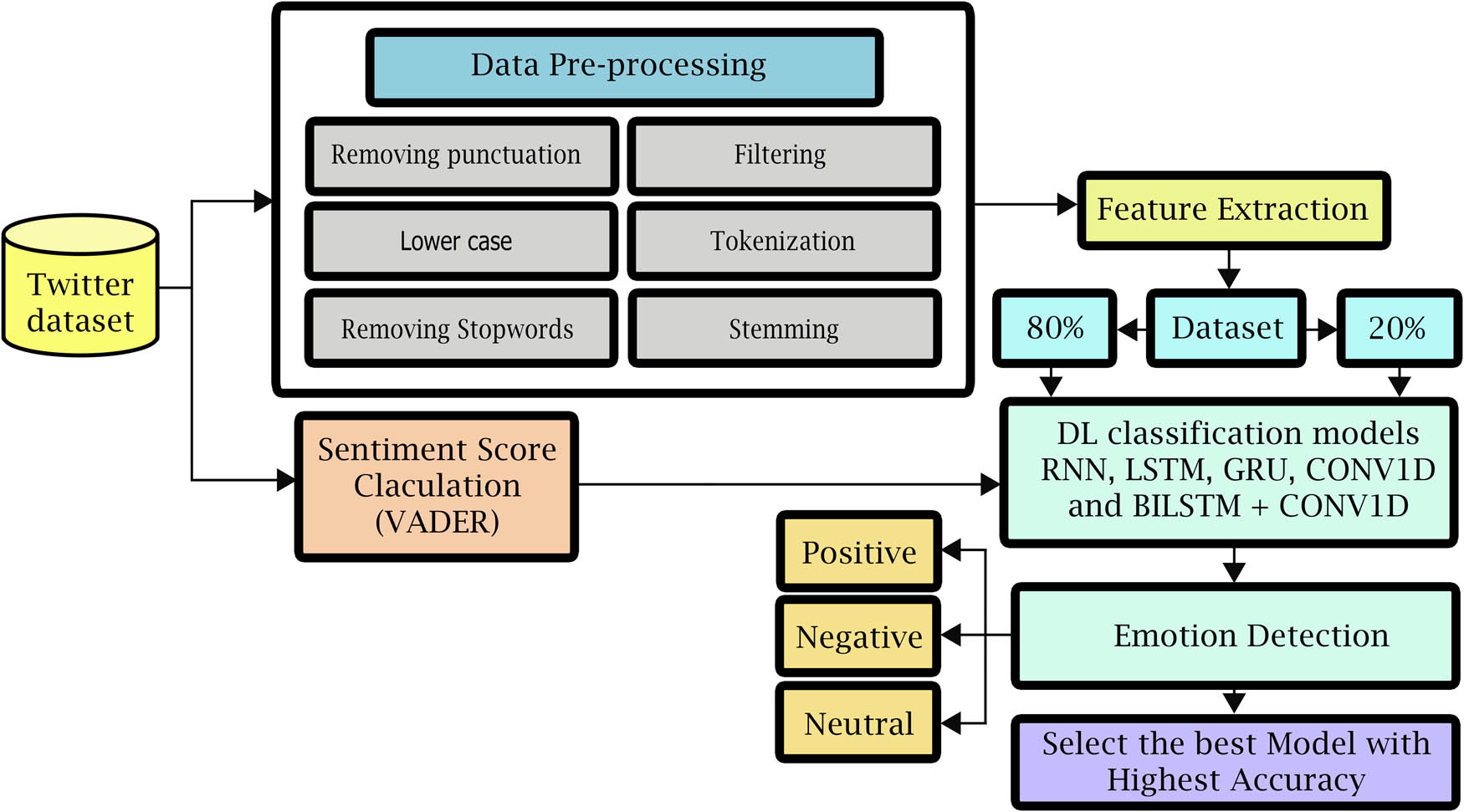
The proposed model for SA classification.
This model is distinguished by many advantages, as it relied on the LSTM method, which is characterized by its great ability to store data for a long time, which allowed the model to have a great ability to learn, including predicting effectively, which resulted in great accuracy in predicting the price of the cryptocurrency.
Table 1 presents an overview of each study’s literature evaluation, methodologies employed, and limitations. The findings indicate that deficiencies such as inaccuracies, reliance on rudimentary techniques, or limited sample sizes are common constraints encountered in the research. In the course of our study, we employed a variety of methodologies, including RNNs, LSTM networks, GRUs, CONV1D, Bi-LSTM + CONV1D, and several datasets of substantial magnitude sourced from the Kaggle platform. To extract features, we employed the Fasttext technique. The utilization of these various strategies contributed to the enhancement of accuracy.
5 Proposed model testing
This research aims to conduct experiments and evaluations on five DL models, namely RNN, LSTM, GRU, Bi-LSTM + CONV1D, and CONV1D. These experiments aim to assess their effectiveness in classifying the sentiment of BTC-related tweets.
5.1 Dataset
We downloaded BTC tweets from the Kaggle website, the dataset is available at Kaggle (https://www.kaggle.com/datasets/kaushiksuresh147/bitcoin-tweets), from February 10, 2021, to January 28, 2022. More than 1.5 million tweets were collected and tested using the suggested models to create the dataset. The research concentrated on SA of tweets to determine precisely and accurately how people felt about BTC. The dataset has a diverse range of columns, including user name, user location, a user created, and other information, as well as the tweet and user ratings, such as how many people marked the tweet as a favorite and the total number of user followers. Among these, the research particularly focuses on tweet text. The dataset was not labeled as positive, negative, or neutral, so this research used the VADER classifier to calculate polarity classification into positive, negative, or neutral.
5.2 Data preprocessing
The preliminary stage of the experiment is data preprocessing, which converts the raw data into an easily readable format to enhance the effectiveness and accuracy of the analysis; preprocessing is regarded as a vital step that must be completed before data are fed to the DL models, especially when the dataset being studied has a textual nature. There were several steps taken during the processing. Figure 2 shows tweets after preprocessing.

Tweets after preprocessing.
Removing punctuation: This eliminates punctuation, including commas, full stops, and exclamation points.
Convert to lower case: The tweets’ text has been lowercase. The analysis is case-sensitive; thus, this is a crucial step. For example, consider “HAPPY” and “happy” two different words.
Filtering: Remove all URL links, e.g., http://youtube.com, and delete tags from other usernames, which frequently start with an @ symbol.
Tokenization: Splitting of text into words and symbols.
Removing stop words: Deleting the stop words from the tweet text that are worthless in terms of SA, such as a, an, the, and all prepositions.
Stemming: Stemming is stripping words of their affixes and returning them to their original forms. Example: increases, increases, and increased are variations of increase.
5.3 Sentiment score calculation (VADER)
VADER is a dictionary- and rule-based open-source Python library for SA [31]. This library does not require text data for training and is appropriate for various texts, including social media. VADER calculates the input statement’s positive, negative, and neutral scores and offers a compound score, which is a numeric number between −1 and +1. Generally, a compound score between −1 and −0.05 is considered negative, one between 0.05 and 1 is regarded as positive, and the other values are considered neutral [8], as shown in Figure 3.

VADER sentiment score calculation.
5.4 Feature extraction
Identifying the word embedding method to transform the text into numerical representations is the first of the two key phases discussed in this section; in our case, it is FastText vector embedding. The second involves feeding the numerical representations of the text to the DL models for classification. Researchers from Facebook proposed FastText embedding in 2016 as an improvement to Word2Vec, an unsupervised learning algorithm to produce word vector representations, as explained in Section 3.3. This approach yields a matrix representing the dataset’s text as vectors. In order to create classification models, the results were obtained as vectors, which could be fed to the five DL algorithms.
5.5 DL models for sentiment classification
In this section, we present five DL classifiers as part of our proposal as follows: (1) RNN, (2) LSTM, (3) GRU, (4) Bi-LSTM + CONV1D, and (5) CONV1D. The architectural details of these models are presented in Tables 2–6.
RNN model
| Layer (type) | Output shape | Param # |
|---|---|---|
| embedding (Embedding) | (None, 50, 300) | 30,000,000 |
| simple_rnn (SimpleRNN) | (None, 50, 300) | 180,300 |
| simple_rnn (SimpleRNN) | (None, 64) | 23,360 |
| dense (Dense) | (None, 32) | 2,080 |
| dense_1 (Dense) | (None, 3) | 99 |
Total params: 30,205,839. Trainable params: 205,839. Non-trainable params: 30,000,000.
LSTM model
| Layer (type) | Output shape | Param # |
|---|---|---|
| Embedding_2 (Embedding) | (None, 50, 300) | 3,000,0000 |
| lstm_2 (LSTM) | (None, 50, 300) | 721,200 |
| lstm_3 (LSTM) | (None, 100) | 160,400 |
| dense_4 (Dense) | (None, 32) | 3,232 |
| dense_5 (Dense) | (None, 3) | 99 |
Total params: 30,884,931. Trainable params: 884,931. Non-trainable params: 30,000,000.
GRU model
| Layer (type) | Output shape | Param # |
|---|---|---|
| embedding_1 (Embedding) | (None, 50, 300) | 3,000,0000 |
| gru (GRU) | (None, 50, 200) | 301,200 |
| gru_1 (GRU) | (None, 100) | 90,600 |
| dense_2 (Dense) | (None, 32) | 3,232 |
| dense_3 (Dense) | (None, 3) | 99 |
Total params: 30,395,131. Trainable params: 395,131. Non-trainable params: 30,000,000.
Bi-LSTM + CONV1D model
| Layer (type) | Output shape | Param # |
|---|---|---|
| embedding (Embedding) | (None, 50, 300) | 3,000,0000 |
| conv1d (CONV1D) | (None, 50, 32) | 9,632 |
| max_pooling1d(Max_pooling1D) | (None, 25, 32) | 0 |
| bidirectional (Bidirectional) | (None, 200) | 106,400 |
| dropout (Dropout) | (None, 200) | 0 |
| dense (Dense) | (None, 32) | 6,432 |
| dense_1 (Dense) | (None, 3) | 99 |
Total params: 30,122,563. Trainable params: 122,563. Non-trainable params: 30,000,000.
CONV1D model
| Layer (type) | Output shape | Param # |
|---|---|---|
| embedding (Embedding) | (None, 50, 300) | 30,000,000 |
| conv1d (CONV1D) | (None, 50, 64) | 134,464 |
| max_pooling1d (Max_pooling1D) | (None, 25, 64) | 0 |
| conv1d (CONV1D) | (None, 25, 64) | 28,736 |
| global_max_pooling1d | (None, 64) | 0 |
| dropout (Dropout) | (None, 64) | 0 |
| dense (Dense) | (None, 32) | 2,080 |
| dense_1 (Dense) | (None, 3) | 99 |
Total params: 30,165,379. Trainable params: 165,379. Non-trainable params: 30,000,000.
5.5.1 RNN model
When learning the embedding for each word in the training datasets, the “function embedding” layer is initially configured with random weights. The maximum length is 50, and the maximum output dimensions are 300. The matrix of the results is 50 × 300. The initial layer of the model is a simple RNN, which is responsible for accepting the vector generated by the process of word embedding. The model has a single RNN layer comprising 300 filters. These filters acquire and process data before forwarding it to the subsequent layer. The findings are presented in a matrix of 50 rows and 300 columns. The subsequent layer comprises a basic RNN that produces a matrix of dimensions 1 × 64. The classifier subsequently utilizes this matrix. Subsequently, the final phase within the model encompasses two fully connected layers. The initial layer employs the rectified linear unit (ReLU) as the chosen activation function (AF), comprising 32 nodes. The subsequent layer employs Softmax as the designated AF, containing three nodes. This configuration facilitates generating a multiclass categorical probability distribution, effectively reducing the vector to three elements. These elements correspond to the predicted output categories of “positive,” “negative,” or “neutral.” The Adam optimizer was employed to compute the learning rate in the present model.
5.5.2 LSTM model
The second DL classifier preprocessing is done on the input data to restructure it for the embedding matrix. The maximum length is 50, and the output dimensions are 300. The matrix of the results is 50 × 300. LSTM is the model’s first layer and gets the vector created by word embedding. The model has a single LSTM layer with 300 filters responsible for capturing and manipulating data before transmitting it to the subsequent layer. The results are presented in a matrix of 50 rows and 300 columns. The subsequent layer consists of an additional LSTM unit responsible for producing a matrix of dimensions 1 × 100. The classifier then uses this matrix. The model classifier is composed of two fully connected layers. The first layer employs the ReLU activation function with 32 nodes. The final layer utilizes the Softmax activation function with three nodes. The Adam optimization approach is used for the model.
5.5.3 GRU model
In the third DL classifier, the output from the embedding layer’s maximum length is 50, and the output dimensions are 300. The matrix of the results is 50 × 300. The first layer of the model is GRU, which receives the vector generated by word embedding. The model architecture includes a single GRU layer with 200 filters, responsible for capturing and processing input before forwarding it to subsequent layers. The results are shown in a matrix with dimensions of 50 rows and 200 columns. The subsequent layer consists of an additional GRU, responsible for producing a matrix of dimensions 1 × 100. The classifier then uses this matrix. The model classifier is composed of two fully connected layers. The first layer comprises 32 nodes and utilizes the ReLU activation function. The final layer, on the other hand, consists of three nodes and employs the Softmax activation function. The Adam optimizer approach is used in this model.
5.5.4 Bi-LSTM + Conv1D model
In the fourth DL classifier, the output from the embedding layer’s maximum length is 50, and the output dimensions are 300. The matrix of the results is 50 × 300. CONV1D serves as the model’s first layer and gets the vector created by word embedding. The model has a single CONV1D layer, including 32 filters responsible for data acquisition, processing, and subsequent propagation to the subsequent layer. The findings are presented in a matrix of 50 rows and 32 columns. A maximum-pooling layer is a common practice after a CNN layer. This is done to reduce the complexity of the output and mitigate the risk of overfitting the input. Consequently, the resulting matrix for this layer has dimensions of 25 × 32. The subsequent layer consists of a bidirectional LSTM model, which produces a matrix of dimensions 1 × 200. The classifier then uses this matrix. The use of a dropout layer in DL serves as a regularization technique to mitigate the issue of overfitting. Its primary function is to enforce independence among the units by preventing codependency. The model classifier is composed of two fully connected layers. The first layer comprises 32 nodes and utilizes the ReLU activation function. The final layer, on the other hand, consists of three nodes and employs the Softmax activation function. The Adam optimizer approach is used for the model.
5.5.5 CONV1D model
In the fifth DL classifier, the output from the embedding layer has a maximum length of 50, and the output dimensions are 300. The matrix of the results is 50 × 300. CONV1D serves as the model’s first layer and gets the vector created by word embedding. The model has a single CONV1D layer, including 64 filters responsible for data acquisition, processing, and subsequent transmission to the subsequent layer. The findings are presented in a matrix of 50 rows and 64 columns. Applying a maximum pooling layer follows a CNN layer to enhance the output’s simplicity and mitigate overfitting.
Consequently, the resulting matrix dimensions for this layer are 25 × 64. The second CNN is a CONV1D that produces a matrix of size 25 × 64, which is then used by the classifier. The Max Pooling1D layer reduces the dimensionality of the input representation by selecting the maximum value from each time dimension. This layer replaces flattening and occasionally even dense layers in classifiers and lowers the dimensionality of the feature maps produced by some convolutional layers. The dropout layer prevents overfitting problems. Next, the model classifier comprises 2 fully connected layers, the first using ReLU with 32 nodes, the last using Softmax with 3 nodes, and the Adam optimizer method.
6 Experimental results and discussion
This section provides a discussion of the findings obtained from the experiment.
6.1 Model training
In the first phase, we divided the dataset into two groups, 80% for training and 20% for testing, then trained using DL models to identify the best DL model. As described in Section 6.3, four evaluation measures were used to analyze and compare the DL classifiers: accuracy, precision, recall, and F1 score.
6.2 Epochs
The term “epoch” refers to the number of iterations performed on the training set. The generalization ability of the model demonstrates improvement with an increase in epochs. Nevertheless, when the number of epochs is very large, it might lead to the occurrence of overfitting, hence reducing the model’s ability to generalize [49]. Hence, selecting the optimal number of epochs is of utmost importance. In the present study, a total of 10 epochs were used.
Tables 7–11 show each epoch (loss, val_loss, accuracy, and val_accuracy) on the various DL models. As shown in Figures 4–8, the loss of the model reduces with each epoch during both the training and testing phases, suggesting that the model is performing optimally. The model’s accuracy for the training and testing phases is shown in Figures 9–13.
Loss, Val loss, accuracy, Val accuracy of CONV1D model
| Epoch | Loss | Val_Loss | Accuracy | Val_Accuracy |
|---|---|---|---|---|
| 1/10 | 0.1748 | 0.1427 | 0.9307 | 0.9414 |
| 2/10 | 0.1316 | 0.1267 | 0.9464 | 0.9482 |
| 3/10 | 0.1176 | 0.1245 | 0.9524 | 0.9493 |
| 4/10 | 0.1090 | 0.1199 | 0.9564 | 0.9511 |
| 5/10 | 0.1030 | 0.1208 | 0.9591 | 0.9525 |
Loss, Val loss, accuracy, Val accuracy OF LSTM model
| Epoch | Loss | Val_Loss | Accuracy | Val_Accuracy |
|---|---|---|---|---|
| 1/10 | 0.2274 | 0.1679 | 0.9127 | 0.9299 |
| 2/10 | 0.1622 | 0.1345 | 0.9336 | 0.9458 |
| 3/10 | 0.1390 | 0.1187 | 0.9423 | 0.9505 |
| 4/10 | 0.1265 | 0.1103 | 0.9475 | 0.9540 |
| 5/10 | 0.1188 | 0.1050 | 0.9507 | 0.9562 |
Loss, Val loss, accuracy, Val accuracy of RNN model
| Epoch | Loss | Val_Loss | Accuracy | Val_Accuracy |
|---|---|---|---|---|
| 1/10 | 0.4037 | 0.4055 | 0.8697 | 0.8700 |
| 2/10 | 0.4045 | 0.4036 | 0.8700 | 0.8700 |
| 3/10 | 0.4046 | 0.4037 | 0.8700 | 0.8700 |
| 4/10 | 0.4045 | 0.4031 | 0.8700 | 0.8700 |
| 5/10 | 0.4041 | 0.4032 | 0.8700 | 0.8700 |
Loss, Val loss, accuracy, Val accuracy OF GRU model
| Epoch | Loss | Val_Loss | Accuracy | Val_Accuracy |
|---|---|---|---|---|
| 1/10 | 0.1695 | 0.1365 | 0.9315 | 0.9431 |
| 2/10 | 0.1174 | 0.1123 | 0.9510 | 0.9533 |
| 3/10 | 0.1041 | 0.1069 | 0.9570 | 0.9565 |
| 4/10 | 0.0960 | 0.1041 | 0.9607 | 0.9570 |
| 5/10 | 0.0899 | 0.1044 | 0.9636 | 0.9582 |
Loss, Val loss, accuracy, Val accuracy OF Bi-LSTM + CONV1D model
| Epoch | Loss | Val_Loss | Accuracy | Val_Accuracy |
|---|---|---|---|---|
| 1/10 | 0.1637 | 0.1311 | 0.9343 | 0.9447 |
| 2/10 | 0.1276 | 0.1235 | 0.9460 | 0.9489 |
| 3/10 | 0.1199 | 0.1161 | 0.9494 | 0.9509 |
| 4/10 | 0.1153 | 0.1124 | 0.9514 | 0.9531 |
| 5/10 | 0.1118 | 0.1099 | 0.9531 | 0.9534 |

COV1D model loss for training and testing.
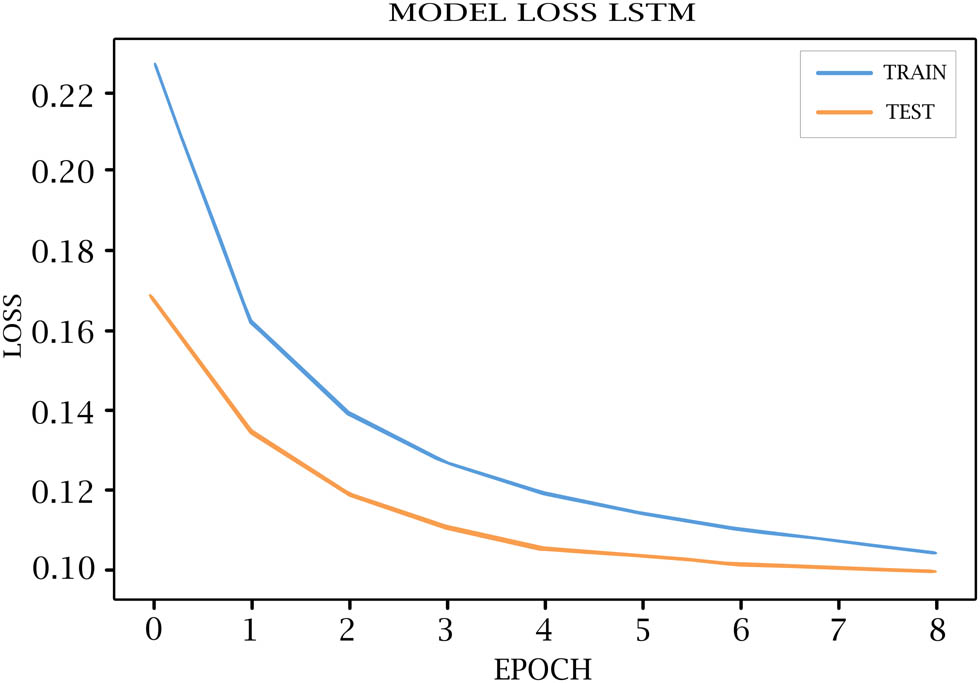
LSTM model loss for training and testing.
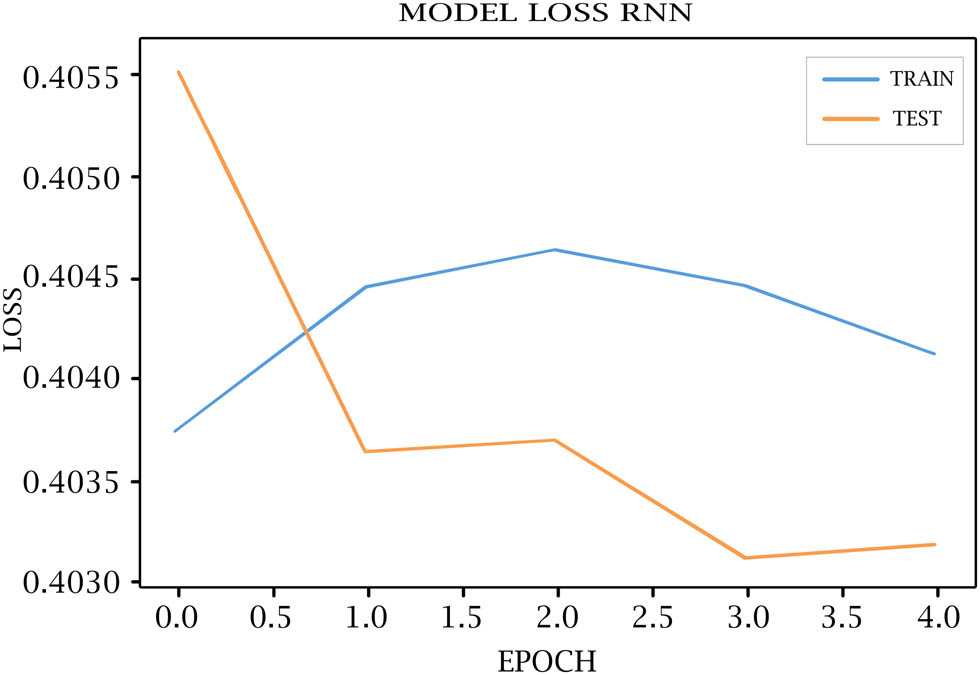
RNN model loss for training and testing.
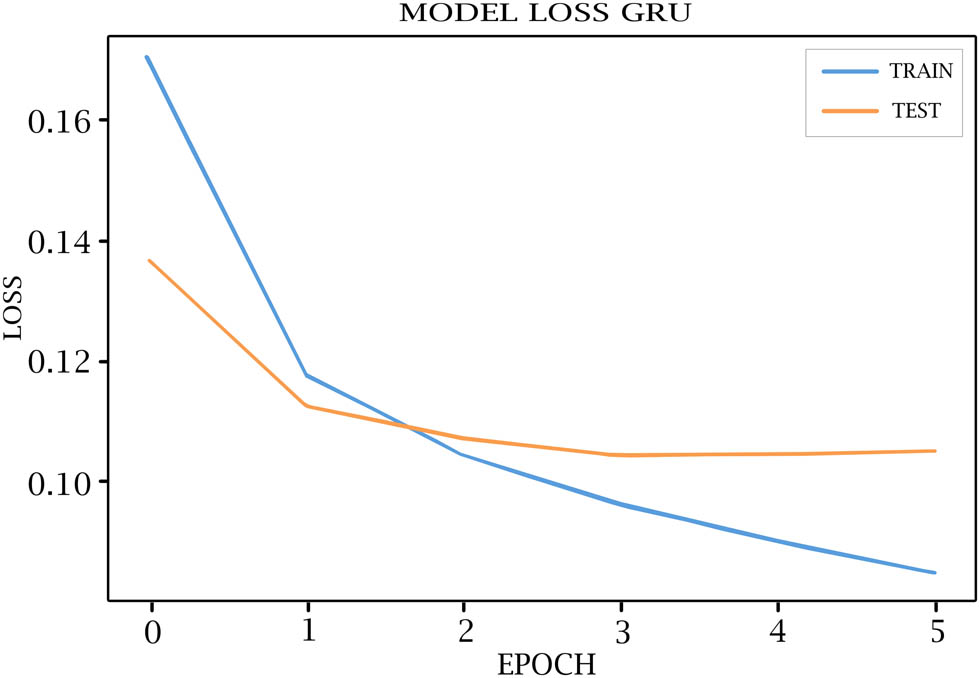
GRU model loss for training and testing.
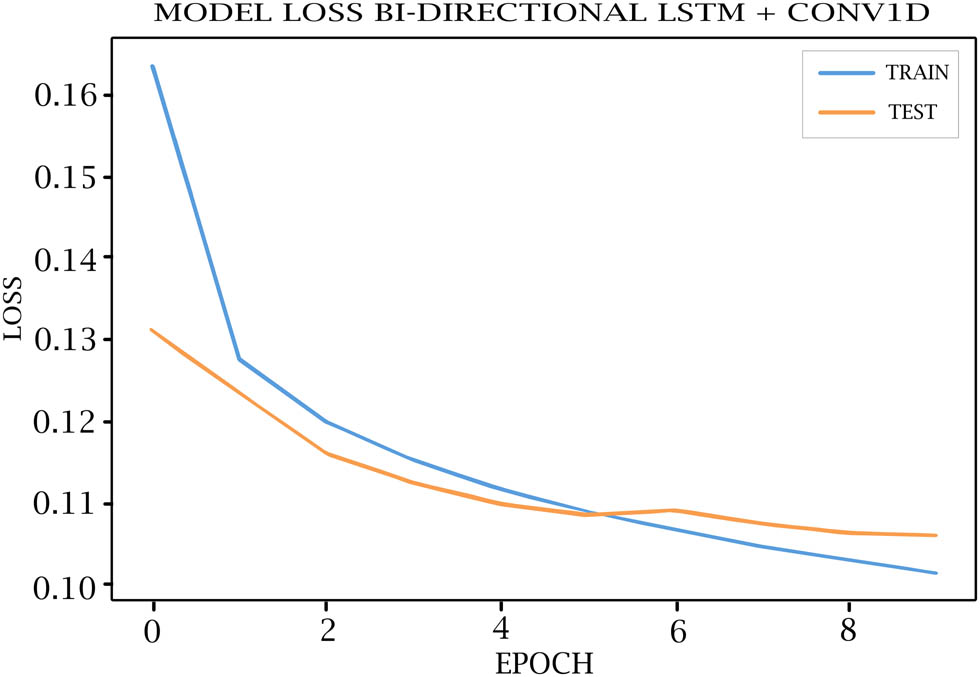
Bi-LSTM + CONV1D model loss for training and testing.
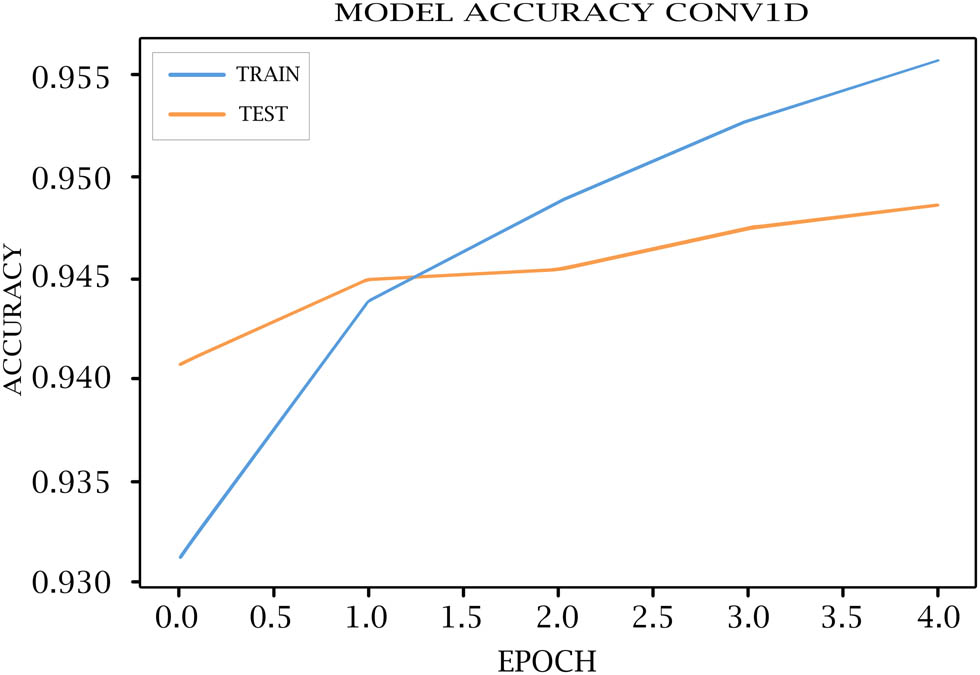
Cov1D model accuracy for training and testing.
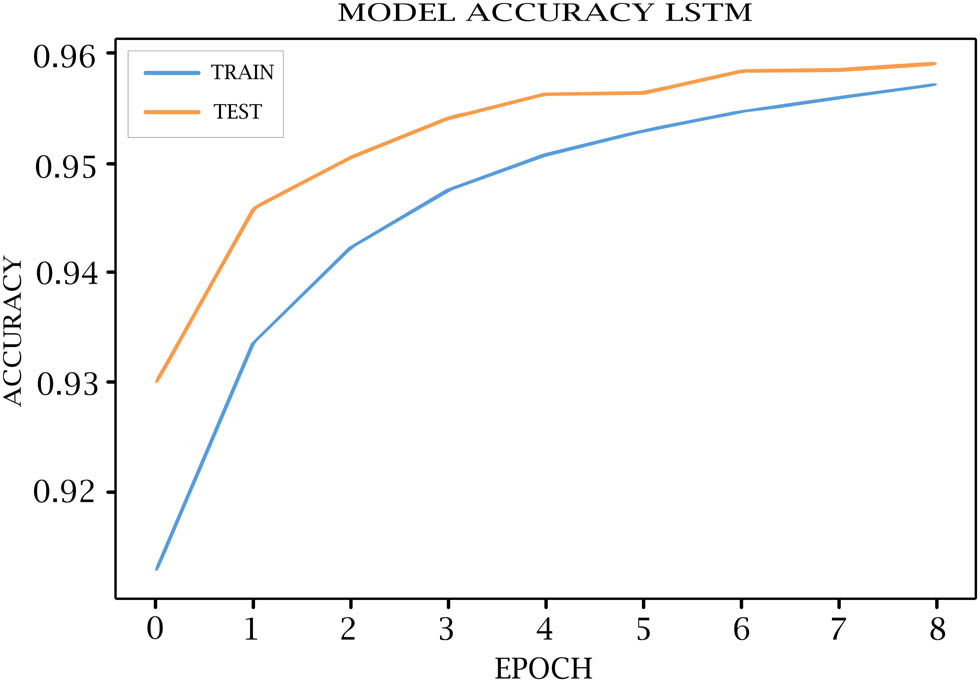
LSTM model accuracy for training and testing.
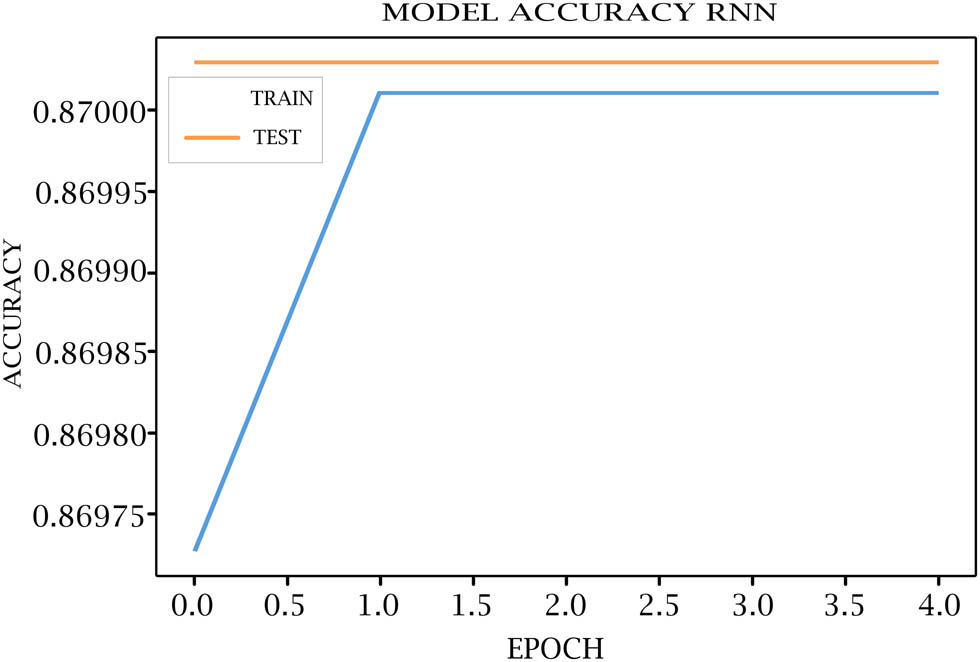
RNN model accuracy for training and testing.
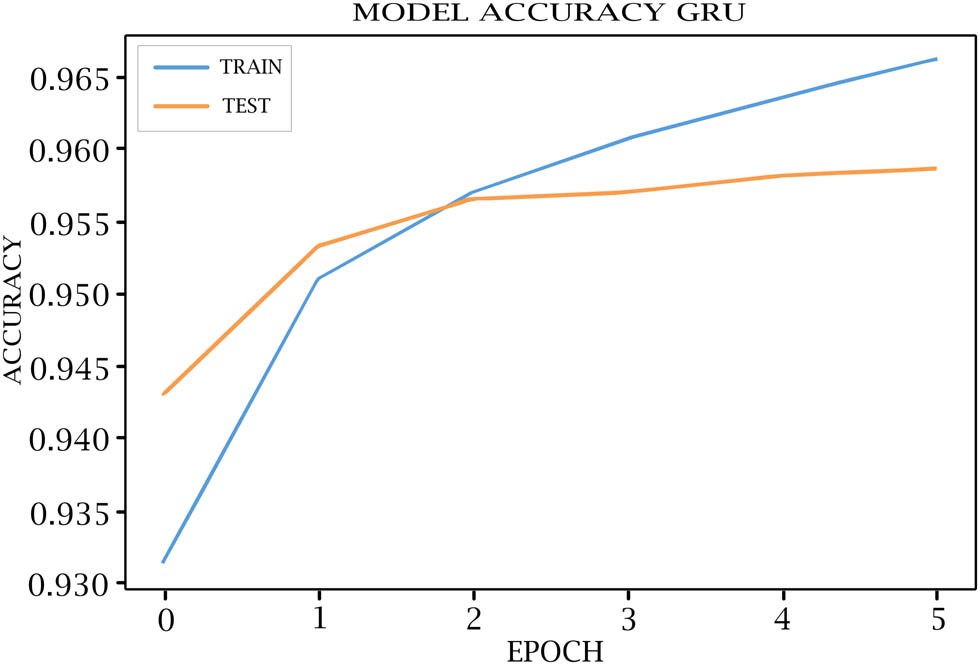
GRU model accuracy for training and testing.
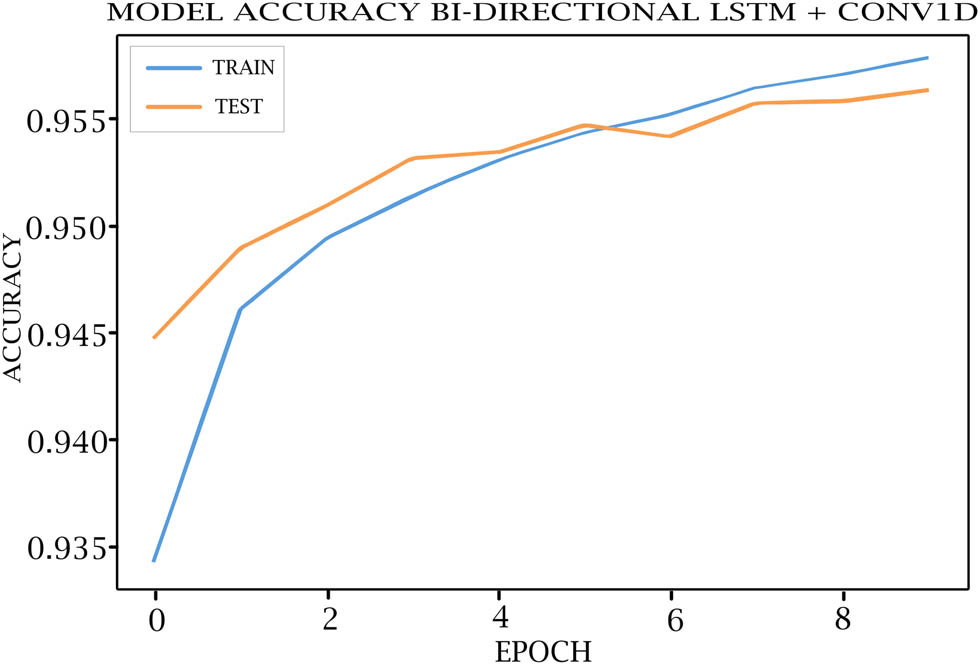
Bi-LSTM + CONV1D model accuracy for training and testing.
6.3 Evaluation metrics
We have evaluated the performance of the DL models with (precision, recall, F1 score, and accuracy).
Precision (P): It reflects the proportion of tuples with positive labels that are genuinely positive and is calculated by the following equation:
Recall (R): It indicates the proportion of successfully identified true positive tuples and is calculated by the following equation:
F 1 score: This is the weighted average of P and R and is calculated by the following equation:
Accuracy: It represents the overall accuracy of the model and is calculated by and is:
True positive (TP): Both real and expected values are true.
True negative (TN): Both real and expected values are false.
False positive (FP): When a real value is false, and the expected value is true.
False negative (FN): When a real value is true, and the expected value is false.
6.4 Confusion matrix
A confusion matrix is used to measure the efficacy of DL classifiers. TP, TN, FP, and FN values are generated over the test data. 0 represents the negative values, 1 represents the positive values, and 2 represents the neutral values. Figures 14–18 show the confusion matrix in DL models. Table 12 and Figure 19 show the negative, positive, and neutral sentiment counts for BTC tweets.
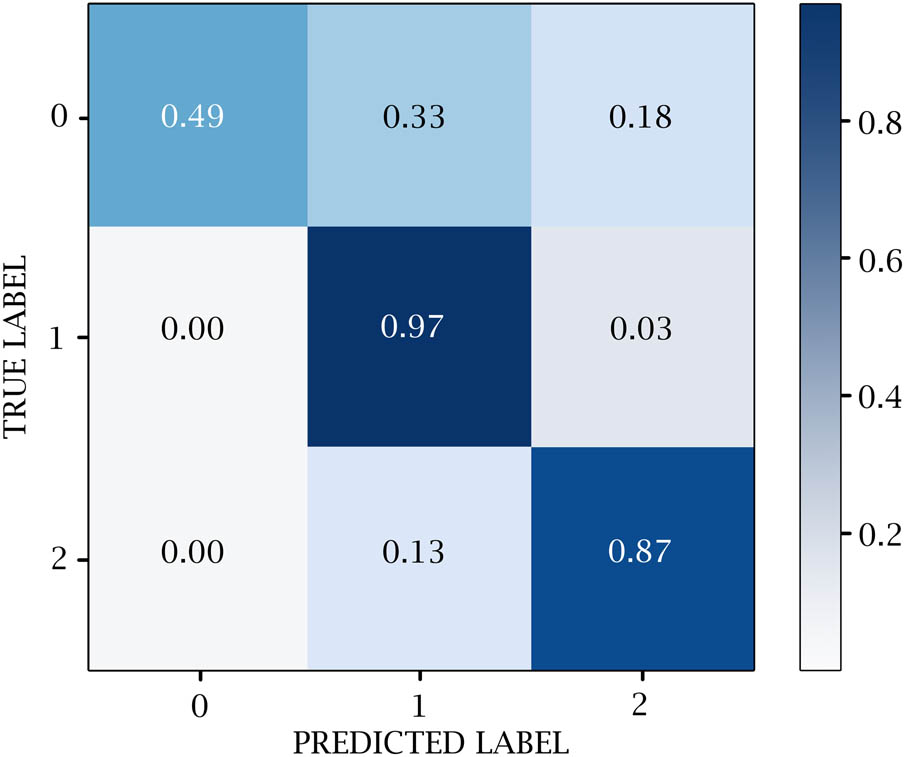
CONV1D confusion matrix.
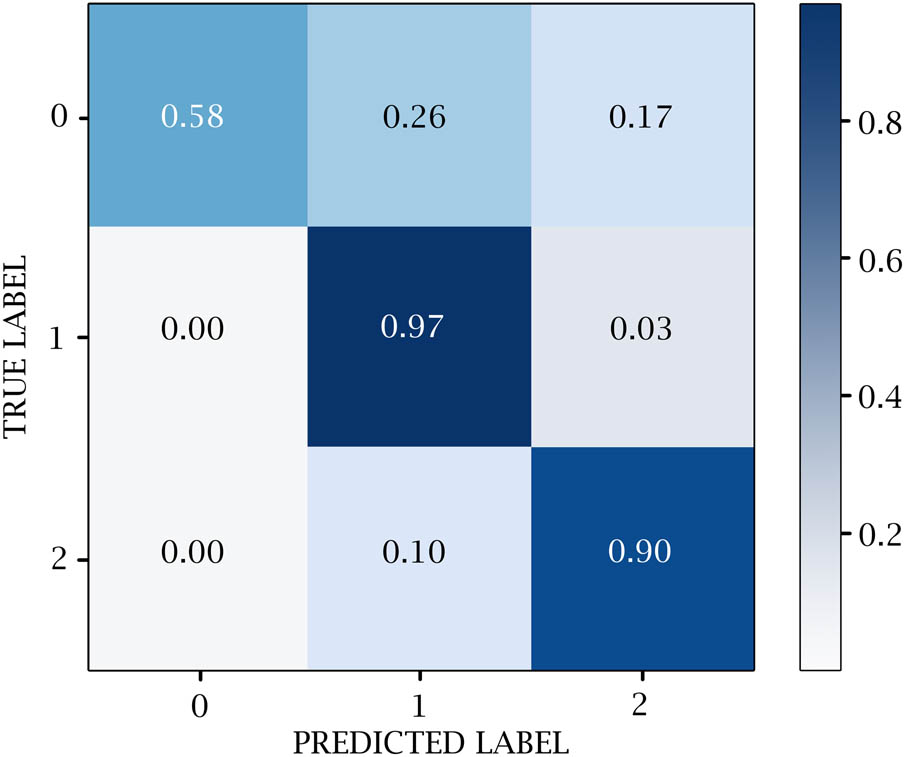
LSTM confusion matrix.

RNN confusion matrix.
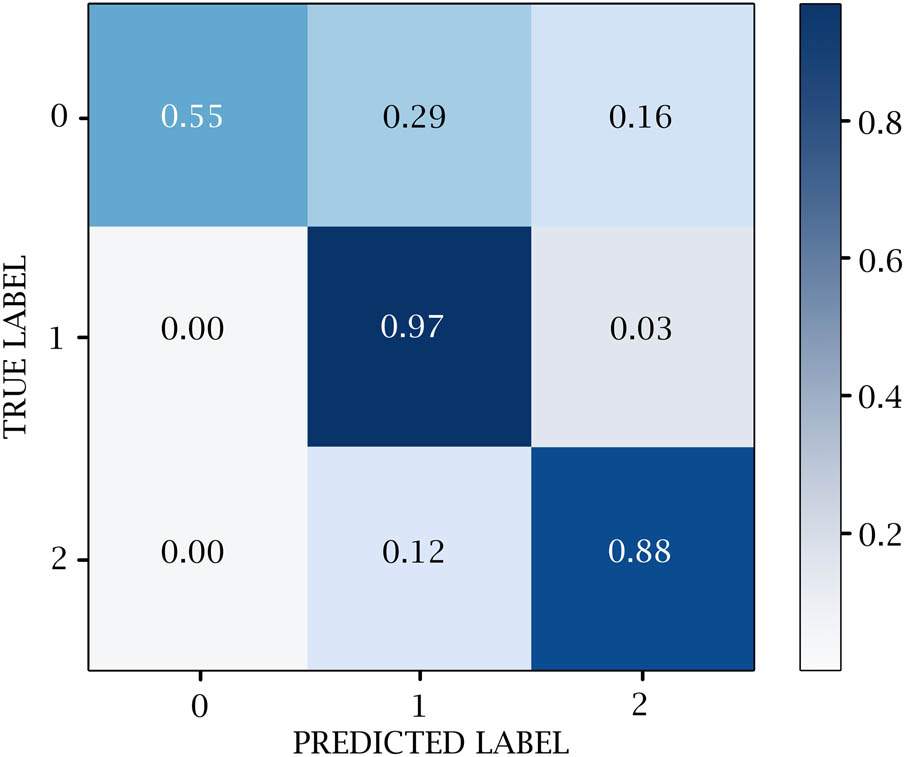
GRU confusion matrix.
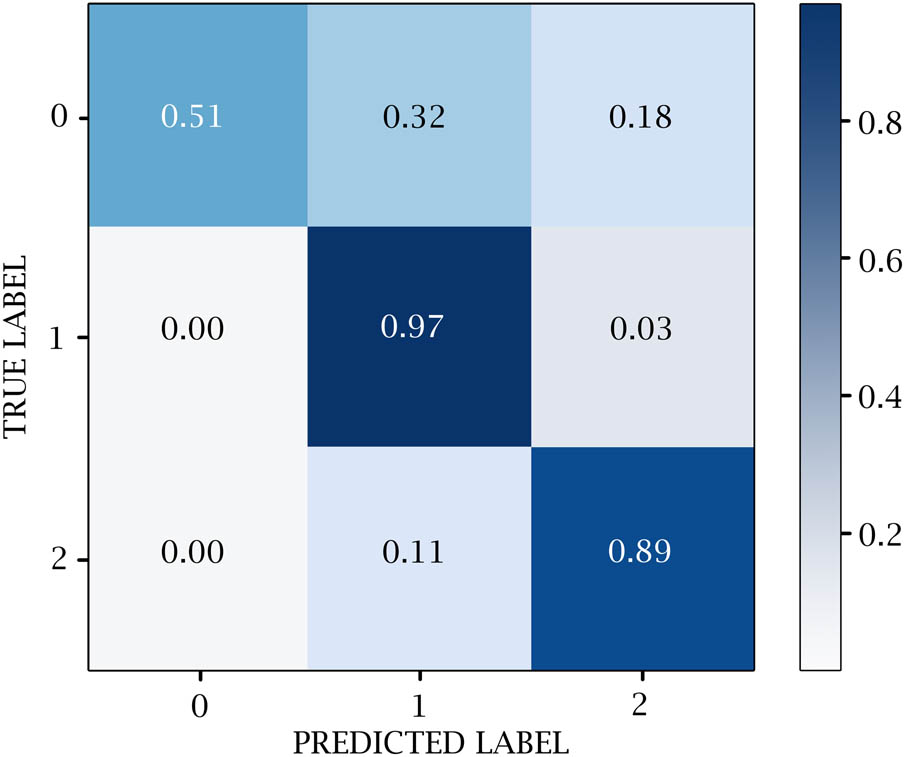
Bi-LSTM + CONV1D confusion matrix.
Count of negative, positive, and neutral sentiments
| Model name | Negative count | Positive count | Neutral count |
|---|---|---|---|
| CONV1D | 641 | 171,580 | 17,810 |
| LSTM | 1,082 | 202,714 | 26,368 |
| RNN | 0 | 208,806 | 0 |
| GRU | 1,058 | 202,840 | 25,985 |
| Bi-LSTM + CONV1D | 949 | 202,458 | 26,114 |
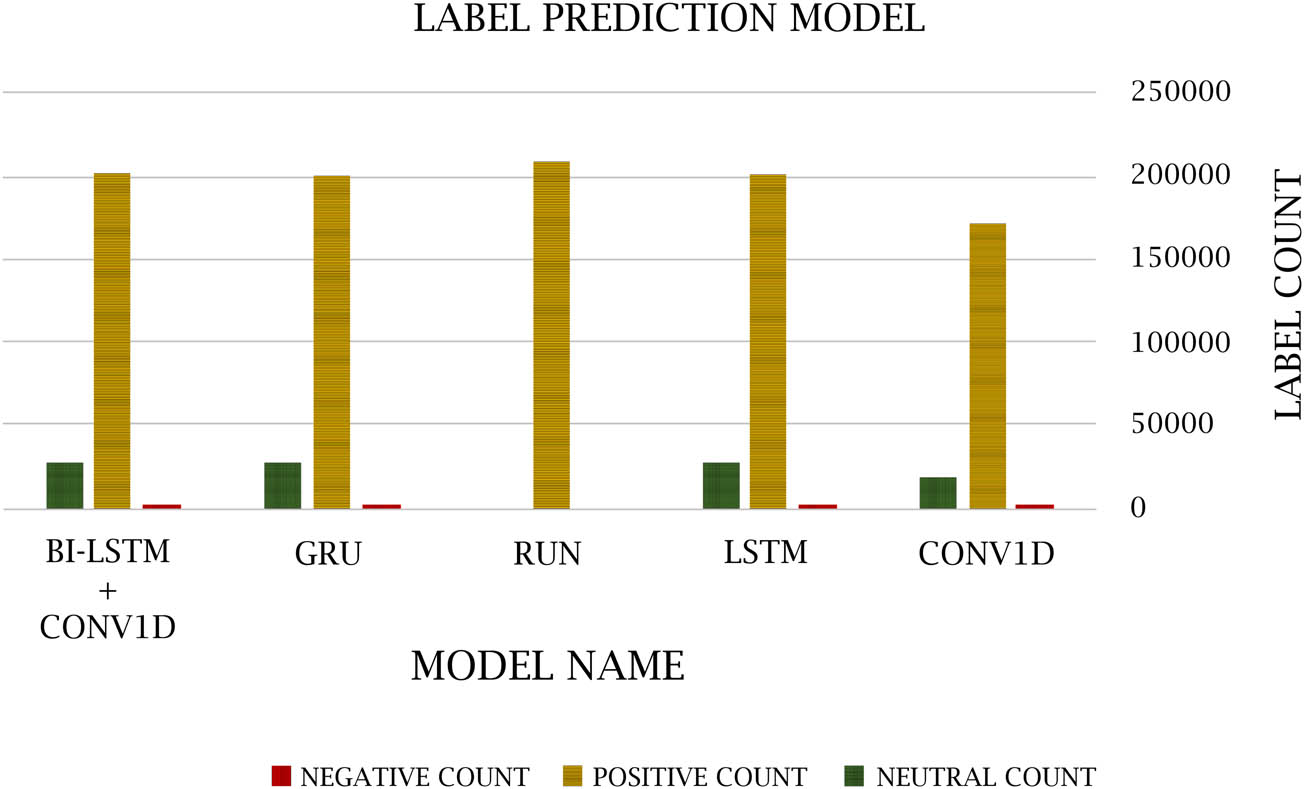
Negative, positive, and neutral sentiments.
6.5 DL Classification model Outcomes
This section discussed the results of classification models obtained using a DL classifier. The performance of classification outcomes in terms of accuracy, recall, and F1-score is shown in Tables 13–17. Figure 20 shows the DL models’ accuracy.
Evaluation results for CONV1D model
| Class | Precision | Recall | F1-Score | Accuracy |
|---|---|---|---|---|
| 0 | 0.93 | 0.49 | 0.64 | 0.95 |
| 1 | 0.98 | 0.97 | 0.97 | |
| 2 | 0.80 | 0.87 | 0.83 | |
| Macro avg | 0.90 | 0.78 | 0.82 | |
| Weighted avg | 0.96 | 0.95 | 0.95 |
Evaluation results for LSTM model
| Class | Precision | Recall | F1-Score | Accuracy |
|---|---|---|---|---|
| 0 | 0.86 | 0.58 | 0.69 | 0.96 |
| 1 | 0.98 | 0.97 | 0.98 | |
| 2 | 0.90 | 0.90 | 0.85 | |
| Macro avg | 0.88 | 0.82 | 0.84 | |
| Weighted avg | 0.96 | 0.96 | 0.96 |
Evaluation results for RNN model
| Class | Precision | Recall | F1-score | Accuracy |
|---|---|---|---|---|
| 0 | 0.00 | 0.00 | 0.00 | 0.87 |
| 1 | 0.87 | 1.00 | 0.93 | |
| 2 | 0.00 | 0.00 | 0.00 | |
| Macro avg | 0.29 | 0.33 | 0.31 | |
| Weighted avg | 0.76 | 0.87 | 0.81 |
Evaluation results for GRU model
| Class | Precision | Recall | F1-score | Accuracy |
|---|---|---|---|---|
| 0 | 0.89 | 0.55 | 0.68 | 0.96 |
| 1 | 0.98 | 0.97 | 0.98 | |
| 2 | 0.82 | 0.88 | 0.85 | |
| Macro avg | 0.90 | 0.80 | 0.83 | |
| Weighted avg | 0.96 | 0.96 | 0.96 |
Evaluation results for Bi-LSTM + CONV1D model
| Class | Precision | Recall | F1-score | Accuracy |
|---|---|---|---|---|
| 0 | 0.92 | 0.51 | 0.65 | 0.96 |
| 1 | 0.98 | 0.97 | 0.98 | |
| 2 | 0.89 | 0.89 | 0.84 | |
| Macro avg | 0.90 | 0.79 | 0.82 | |
| Weighted avg | 0.96 | 0.96 | 0.96 |
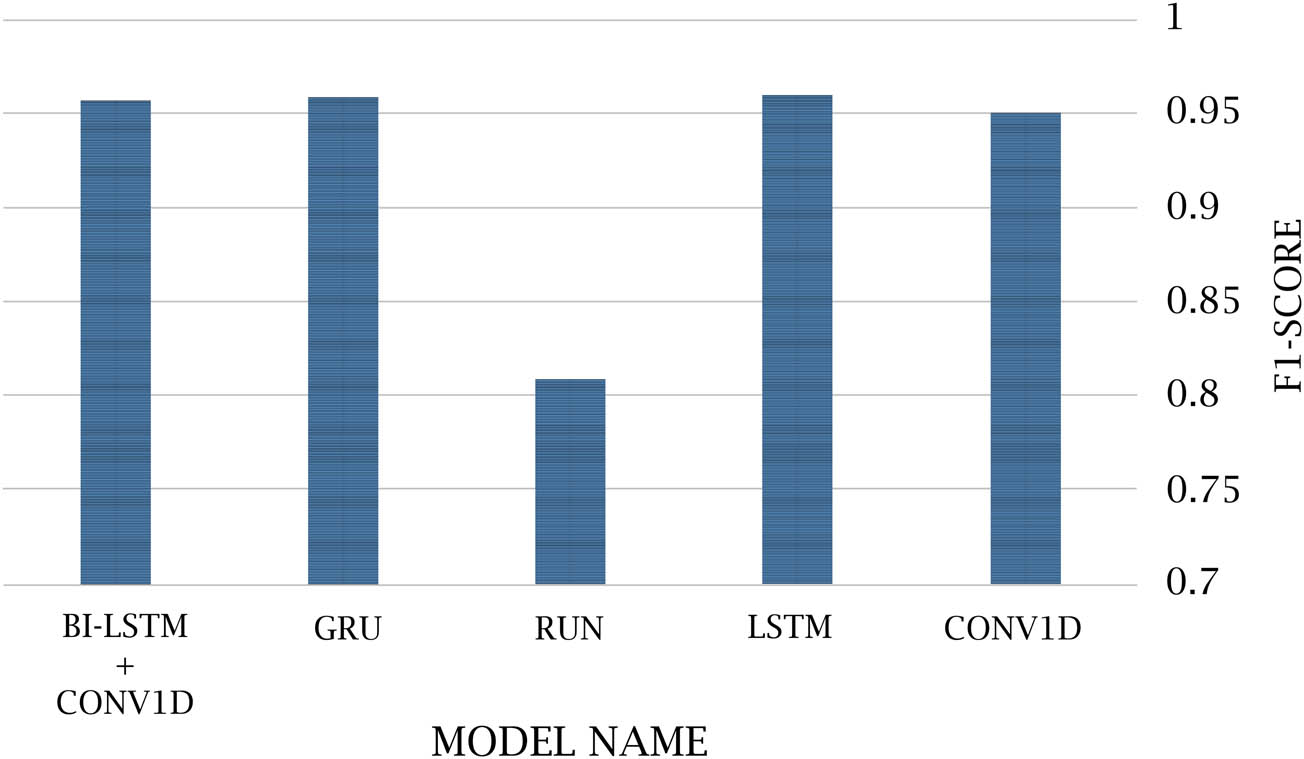
DL model accuracy.
Twitter is a significant, well-liked microblog where users express their perspectives on current events. SA has recently focused mostly on assessing these viewpoints. Researchers have found recording, collecting, and analyzing people’s feelings difficult to overcome these issues. This study suggests DL models for the SA of tweets. In order to improve sentiment classification’s performance and accuracy, we used a DL technique in this article together with CONV1D, LSTM, RNN, GRU, and Bi-LSTM + CONV1D classifier models.
Additionally, the research emphasizes how crucial feature extraction and preprocessing are to the sentiment classification approach. The tweets in the text were divided into a training dataset and a testing dataset for the research, which was based on BTC tweets. For this comparison, we used CONV1D, LSTM, RNN, GRU, and Bi-LSTM + CONV1D. In comparison, the suggested DL classifiers have an accuracy rate of 95.01, 95.95, 80.59, 95.82, and 95.67%, respectively. Table 18 shows the accuracy of DL model classifiers’ results summaries.
Accuracy of DL model result summary
| Model name | F1-score |
|---|---|
| CONV1D | 0.95010 |
| LSTM | 0.95950 |
| RNN | 0.80950 |
| GRU | 0.95822 |
| Bi-LSTM + CONV1D | 0.95672 |
7 Conclusions and future work
Table 1 of the literature evaluation provides a comprehensive description of the techniques used in each research and an overview of the limitations associated with these methodologies. During our investigation, we used analogous and disparate models in conjunction with a considerable-sized dataset. The utilization of models collectively contributed to the enhancement of accuracy.
DL classification models and a FastText-based approach were used to determine the sentiment or polarity of the dataset. Table 18 shows different DL models’ overall accuracy, precision, recall, and F1-score. The performance accuracy of the CONV1D, LSTM, RNN, GRU, and Bi-LSTM + CONV1D models was 95.01, 95.95, 80.59, 95.82, and 95.67%, respectively. The LSTM, GRU, and Bi-LSTM + CONV1D models produce more precise results than other DL models, so as shown in Table 18, the LSTM model gives the best result. This study also used a BTC Twitter dataset with textual information in English.
In the future, we look forward to applying other languages to the proposed model that has been built. We also look forward to using other DL algorithms or hybrid DL models to improve emotion classification accuracy. The epoch size could also be raised to obtain a higher accuracy percentage. We also look forward in the future to presenting a research article that examines the measurement of the correlation between tweets and the subsequent influence on cryptocurrency prices. Finally, we anticipate the utilization of these algorithms across diverse domains to ascertain their efficacy and precision.
8 Research limitations
The following points may delineate the limits of the research:
In this research, an SA was conducted only on the cryptocurrency BTC. There is potential for the expansion of this research to include more digital currencies.
The research was carried out using the BTC comment corpus, which only comprises textual data in the English language. The authors express their anticipation for the future application of the suggested approach to more languages in forthcoming research.
This research focused on classifying comments about the BTC currency and obtaining the highest possible accuracy for analyzing the sentiment of the tweets, and not calculating the correlation coefficient between the tweets and the price of the currency and its effect, whether rising or falling.
Acknowledgments
The authors thank the editor and reviewers for their valuable comments and suggestions that improved the manuscript.
-
Funding information: The authors state no funding involved.
-
Author contributions: Michael Nair: The literature review, the experiment part, producing the result, and Writing parts of the paper; Laila A. Abd-Elmegid: Drawing the paper structure and methodology, introducing the problem, and reviewing the results; Mohamed I. Marie: Reviewing the whole paper, reviewing the results, and analyzing the results.
-
Conflict of interest: The authors declare that there is no conflict of interest.
-
Data availability statement: This research uses an online data set that is appropriately cited within the article and can be found online.
References
[1] Fakharchian S. Designing forecasting assistant of the Bitcoin price based on deep learning using the market sentiment analysis and multiple feature extraction. Soft Comput. 2023;27(24):18803–27.10.1007/s00500-023-09028-5Search in Google Scholar
[2] Parekh R, Patel NP, Thakkar N., Gupta R, Tanwar S, Sharma G, et al. DL-GuesS: Deep learning and sentiment analysis-based cryptocurrency price prediction. IEEE Access. 2022;10:35398–35409. 10.1109/ACCESS.2022.3163305.Search in Google Scholar
[3] Şaşmaz E, Tek FB. Tweet sentiment analysis for cryptocurrencies. Proceedings - 6th International Conference on Computer Science and Engineering, UBMK 2021; 2021. p. 613–8. 10.1109/UBMK52708.2021.9558914.Search in Google Scholar
[4] Sattarov O, Jeon HS, Oh R, Lee JD. Forecasting Bitcoin price fluctuation by twitter sentiment analysis. 2020 International Conference on Information Science and Communications Technologies, ICISCT 2020; Nov. 2020. 10.1109/ICISCT50599.2020.9351527.Search in Google Scholar
[5] Kaur G, Malik K. A sentiment analysis of airline system using machine learning algorithms. Int J Adv Res Eng. 2021;12(1):731–42. 10.34218/IJARET.12.1.2021.066.Search in Google Scholar
[6] Mahto D, Yadav SC, Lalotra GS. Sentiment prediction of textual data using hybrid convbidirectional-LSTM model. Mobile Information Systems. 2022;2022:1068554. 10.1155/2022/1068554.Search in Google Scholar
[7] Kraaijeveld O, de Smedt J. The predictive power of public Twitter sentiment for forecasting cryptocurrency prices. J Int Financ Mark Inst Money. Mar. 2020;65:101188. 10.1016/J.INTFIN.2020.101188.Search in Google Scholar
[8] Ye Z, Wu Y, Chen H, Pan Y, Jiang Q. A stacking ensemble deep learning model for Bitcoin price prediction using twitter comments on Bitcoin. Mathematics. Apr. 2022;10(8):1307. 10.3390/MATH10081307.Search in Google Scholar
[9] Singh C, Imam T, Wibowo S, Grandhi S. A deep learning approach for sentiment analysis of COVID-19 reviews. Appl Sci. Apr. 2022;12(8):3709. 10.3390/APP12083709.Search in Google Scholar
[10] Mardjo A, Choksuchat C. HyVADRF: Hybrid VADER-random forest and GWO for Bitcoin tweet sentiment analysis. IEEE Access. 2022;10:101889–97. 10.1109/ACCESS.2022.3209662.Search in Google Scholar
[11] Kilimci ZH. Sentiment analysis based direction prediction in Bitcoin using deep learning algorithms and word embedding models. Int J Intell Syst Appl Eng. Jun. 2020;8(2):60–5. 10.18201/ijisae.2020261585.Search in Google Scholar
[12] Raju SM, Tarif AM. Real-time prediction of Bitcoin price using machine learning techniques and public sentiment analysis. ArXiv. Jun. 2020. 10.48550/arXiv.2006.14473.Search in Google Scholar
[13] Umer M, Ashraf I, Mehmood A, Kumari S, Ullah S, Sang Choi G. Sentiment analysis of tweets using a unified convolutional neural network-long short-term memory network model. Comput Intell. Feb. 2021;37(1):409–34. 10.1111/COIN.12415.Search in Google Scholar
[14] Yao G. Deep learning-based text sentiment analysis in Chinese international promotion. Secur Commun Netw. 2022;2022:1–10. 10.1155/2022/7319656.Search in Google Scholar
[15] Hussein M, Özyurt F. A new technique for sentiment analysis system based on deep learning using chi-square feature selection methods. Balk J Electr Computer Eng. Oct. 2021;9(4):320–6. 10.17694/bajece.887339.Search in Google Scholar
[16] Passalis N, Avramelou L, Seficha S, Tsantekidis A, Doropoulos S, Makris G, et al. Multisource financial sentiment analysis for detecting Bitcoin price change indications using deep learning. Neural Comput Appl. Nov. 2022;34(22):19441–52. 10.1007/S00521-022-07509-6/TABLES/5.Search in Google Scholar
[17] Saha J, Patel S, Xing F, Cambria E. Does social media sentiment predict Bitcoin trading volume? ICIS 2022 Proceedings; Dec. 2022. Accessed: Feb. 20, 2023. [Online]. https://aisel.aisnet.org/icis2022/blockchain/blockchain/3.Search in Google Scholar
[18] Aslam N, Rustam F, Lee E, Washington PB, Ashraf I. Sentiment analysis and emotion detection on cryptocurrency related tweets using ensemble LSTM-GRU model. IEEE Access. 2022;10:39313–24. 10.1109/ACCESS.2022.3165621.Search in Google Scholar
[19] Huang X, Zhang W, Tang X, Zhang M, Surbiryala J, Iosifidis V, et al. LSTM based sentiment analysis for cryptocurrency prediction. Lecture notes in computer science (including subseries Lecture Notes in Artificial Intelligence and Lecture Notes in Bioinformatics) LNCS. Vol. 12683; 2021. p. 617–21. 10.1007/978-3-030-73200-4_47/TABLES/2.Search in Google Scholar
[20] Jahjah FH, Rajab M. Impact of twitter sentiment related to Bitcoin on stock price returns. J Eng. Jun. 2020;26(6):60–71. 10.31026/J.ENG.2020.06.05.Search in Google Scholar
[21] Pant DR, Neupane P, Poudel A, Pokhrel AK, Lama BK. Recurrent neural network based Bitcoin price prediction by twitter sentiment analysis. Proceedings on 2018 IEEE 3rd International Conference on Computing, Communication and Security, ICCCS 2018; Dec. 2018. p. 128–32. 10.1109/CCCS.2018.8586824.Search in Google Scholar
[22] Onan A. GTR-GA: Harnessing the power of graph-based neural networks and genetic algorithms for text augmentation. Expert Syst Appl. 2023;232:120908. 10.1016/j.eswa.2023.120908.Search in Google Scholar
[23] Onan A. SRL-ACO: A text augmentation framework based on semantic role labeling and ant colony optimization. J King Saud Univ-Computer Inf Sci. 2023;35:101611. 10.1016/j.jksuci.2023.101611.Search in Google Scholar
[24] Onan A. Hierarchical graph-based text classification framework with contextual node embedding and BERT-based dynamic fusion. J King Saud Univ-Computer Inf Sci. 2023;35:101610. 10.1016/j.jksuci.2023.101610.Search in Google Scholar
[25] Onan A. Bidirectional convolutional recurrent neural network architecture with group-wise enhancement mechanism for text sentiment classification. J King Saud Univ-Computer Inf Sci. 2022;34(5):2098–117. 10.1016/j.jksuci.2022.02.025.Search in Google Scholar
[26] Onan A. Sentiment analysis on massive open online course evaluations: a text mining and deep learning approach. Computer Appl Eng Educ. 2021;29(3):572–89. 10.1002/cae.22253.Search in Google Scholar
[27] Onan A, Toçoğlu MA. A term weighted neural language model and stacked bidirectional LSTM based framework for sarcasm identification. IEEE Access. 2021;9:7701–22. 10.1109/ACCESS.2021.3049734.Search in Google Scholar
[28] Beigi G, Hu X, Maciejewski R, Liu H. An overview of sentiment analysis in social media and its applications in disaster relief. Stud Comput Intell. 2016;639:313–40. 10.1007/978-3-319-30319-2_13/TABLES/2.Search in Google Scholar
[29] Ruz GA, Henríquez PA, Mascareño A. Sentiment analysis of Twitter data during critical events through Bayesian networks classifiers. Future Gener Computer Syst. May 2020;106:92–104. 10.1016/J.FUTURE.2020.01.005.Search in Google Scholar
[30] Lazrig I, Humpherys SL. Using machine learning sentiment analysis to evaluate learning impact. Inf Syst Educ J. Feb. 2022;20(1):13–21. Accessed: Feb. 20, 2023. [Online]. https://isedj.org/;https://iscap.info.Search in Google Scholar
[31] Nawaz N, Deep learning-based sentiment analysis and topic modeling on tourism during COVID-19 pandemic. Dec. 27, 2021. Accessed: Feb. 20, 2023. [Online]. https://papers.ssrn.com/abstract=3994359.Search in Google Scholar
[32] Li Y, Yang T. Word embedding for understanding natural language: A survey. Stud Big Data. 2018;26:83–104. 10.1007/978-3-319-53817-4_4/FIGURES/8.Search in Google Scholar
[33] Mojumder P, Hasan M, Hossain MF, Hasan KMA. A study of fasttext word embedding effects in document classification in bangla language. Lecture Notes of the Institute for Computer Sciences, Social-Informatics and Telecommunications Engineering, LNICST. Vol. 325; 2020. p. 441–53. 10.1007/978-3-030-52856-0_35/TABLES/5.Search in Google Scholar
[34] Dang CN, Moreno-García MN, de La Prieta F. Hybrid deep learning models for sentiment analysis. Complexity. 2021;2021. 10.1155/2021/9986920.Search in Google Scholar
[35] Umer M, et al. Impact of convolutional neural network and FastText embedding on text classification. Multimed Tools Appl. Feb. 2023;82(4):5569–85. 10.1007/S11042-022-13459-X/FIGURES/3.Search in Google Scholar
[36] Karlemstrand R, Leckström E, Using twitter attribute information to predict stock prices. arXiv preprint. Stockholm. May 2021. 10.48550/arxiv.2105.01402.Search in Google Scholar
[37] Chandio BA, Imran AS, Bakhtyar M, Daudpota SM, Baber J. Attention-based RU-BiLSTM sentiment analysis model for Roman Urdu. Appl Sci. Apr. 2022;12(7):3641. 10.3390/APP12073641.Search in Google Scholar
[38] Irie K, Csordás R, Urgen Schmidhuber J. The dual form of neural networks revisited: Connecting test time predictions to training patterns via spotlights of attention. PMLR. Jun. 28, 2022;9639–59. Accessed: Feb. 20, 2023. [Online]. https://proceedings.mlr.press/v162/irie22a.html.Search in Google Scholar
[39] Rodrigues AP, Fernandes R, Shetty A, Lakshmanna K, Shafi RM. Real-time twitter spam detection and sentiment analysis using machine learning and deep learning techniques. Comput Intell Neurosci. 2022;2022:1–14. 10.1155/2022/5211949.Search in Google Scholar PubMed PubMed Central
[40] Bhowmik NR, Arifuzzaman M, Mondal MRH. Sentiment analysis on Bangla text using extended lexicon dictionary and deep learning algorithms. Array. Mar. 2022;13:100123. 10.1016/J.ARRAY.2021.100123.Search in Google Scholar
[41] Alam KN, Khan MS, Dhruba AR, Khan MM, Al-Amri JF, Masud M, et al. Deep learning-based sentiment analysis of COVID-19 vaccination responses from twitter data. ArXiv, p. arXiv: 2209.12604. Aug. 2022. 10.48550/ARXIV.2209.12604.Search in Google Scholar
[42] Liu D, Wei A. Regulated LSTM artificial neural networks for option risks. FinTech. Jun. 2022;1(2):180–90. 10.3390/FINTECH1020014.Search in Google Scholar
[43] Bilgili M, Arslan N, Sekertekin A, Yasar A. Application of long short-term memory (LSTM) neural network based on deeplearning for electricity energy consumption forecasting. Turkish J Electr Eng Computer Sci. Jan. 2022;30(1):140–57. 10.3906/elk-2011-14.Search in Google Scholar
[44] Wang C, Yan H, Huang W. AGA-GRU: An optimized GRU neural network model based on adaptive genetic algorithm. J Phys Conf Ser. Nov. 2020;1651(1):012146. 10.1088/1742-6596/1651/1/012146.Search in Google Scholar
[45] Zarzycki K, Ławryńczuk M. Advanced predictive control for GRU and LSTM networks. Inf Sci (N Y). Nov. 2022;616:229–54. 10.1016/J.INS.2022.10.078.Search in Google Scholar
[46] Elfaik H, Nfaoui EH. Deep bidirectional LSTM network learning-based sentiment analysis for Arabic text. J Intell Syst. Jan. 2021;30(1):395–412. 10.1515/JISYS-2020-0021/ASSET/GRAPHIC/J_JISYS-2020-0021_FIG_008.JPG.Search in Google Scholar
[47] Yousaf K, Nawaz T. A deep learning-based approach for inappropriate content detection and classification of youtube videos. IEEE Access. 2022;10:16283–98. 10.1109/ACCESS.2022.3147519.Search in Google Scholar
[48] Mahalakshmi P, Fatima NS. Ensembling of text and images using Deep Convolutional Neural Networks for Intelligent Information Retrieval. Wirel Pers Commun. Nov. 2022;127(1):235–53. 10.1007/S11277-021-08211-X/METRICS.Search in Google Scholar
[49] Xu G, Meng Y, Qiu X, Yu Z, Wu X. Sentiment analysis of comment texts based on BiLSTM, IEEE Access. 2019;7:51522–32. 10.1109/ACCESS.2019.2909919.Search in Google Scholar
© 2024 the author(s), published by De Gruyter
This work is licensed under the Creative Commons Attribution 4.0 International License.
Articles in the same Issue
- Research Articles
- A study on intelligent translation of English sentences by a semantic feature extractor
- Detecting surface defects of heritage buildings based on deep learning
- Combining bag of visual words-based features with CNN in image classification
- Online addiction analysis and identification of students by applying gd-LSTM algorithm to educational behaviour data
- Improving multilayer perceptron neural network using two enhanced moth-flame optimizers to forecast iron ore prices
- Sentiment analysis model for cryptocurrency tweets using different deep learning techniques
- Periodic analysis of scenic spot passenger flow based on combination neural network prediction model
- Analysis of short-term wind speed variation, trends and prediction: A case study of Tamil Nadu, India
- Cloud computing-based framework for heart disease classification using quantum machine learning approach
- Research on teaching quality evaluation of higher vocational architecture majors based on enterprise platform with spherical fuzzy MAGDM
- Detection of sickle cell disease using deep neural networks and explainable artificial intelligence
- Interval-valued T-spherical fuzzy extended power aggregation operators and their application in multi-criteria decision-making
- Characterization of neighborhood operators based on neighborhood relationships
- Real-time pose estimation and motion tracking for motion performance using deep learning models
- QoS prediction using EMD-BiLSTM for II-IoT-secure communication systems
- A novel framework for single-valued neutrosophic MADM and applications to English-blended teaching quality evaluation
- An intelligent error correction model for English grammar with hybrid attention mechanism and RNN algorithm
- Prediction mechanism of depression tendency among college students under computer intelligent systems
- Research on grammatical error correction algorithm in English translation via deep learning
- Microblog sentiment analysis method using BTCBMA model in Spark big data environment
- Application and research of English composition tangent model based on unsupervised semantic space
- 1D-CNN: Classification of normal delivery and cesarean section types using cardiotocography time-series signals
- Real-time segmentation of short videos under VR technology in dynamic scenes
- Application of emotion recognition technology in psychological counseling for college students
- Classical music recommendation algorithm on art market audience expansion under deep learning
- A robust segmentation method combined with classification algorithms for field-based diagnosis of maize plant phytosanitary state
- Integration effect of artificial intelligence and traditional animation creation technology
- Artificial intelligence-driven education evaluation and scoring: Comparative exploration of machine learning algorithms
- Intelligent multiple-attributes decision support for classroom teaching quality evaluation in dance aesthetic education based on the GRA and information entropy
- A study on the application of multidimensional feature fusion attention mechanism based on sight detection and emotion recognition in online teaching
- Blockchain-enabled intelligent toll management system
- A multi-weapon detection using ensembled learning
- Deep and hand-crafted features based on Weierstrass elliptic function for MRI brain tumor classification
- Design of geometric flower pattern for clothing based on deep learning and interactive genetic algorithm
- Mathematical media art protection and paper-cut animation design under blockchain technology
- Deep reinforcement learning enhances artistic creativity: The case study of program art students integrating computer deep learning
- Transition from machine intelligence to knowledge intelligence: A multi-agent simulation approach to technology transfer
- Research on the TF–IDF algorithm combined with semantics for automatic extraction of keywords from network news texts
- Enhanced Jaya optimization for improving multilayer perceptron neural network in urban air quality prediction
- Design of visual symbol-aided system based on wireless network sensor and embedded system
- Construction of a mental health risk model for college students with long and short-term memory networks and early warning indicators
- Personalized resource recommendation method of student online learning platform based on LSTM and collaborative filtering
- Employment management system for universities based on improved decision tree
- English grammar intelligent error correction technology based on the n-gram language model
- Speech recognition and intelligent translation under multimodal human–computer interaction system
- Enhancing data security using Laplacian of Gaussian and Chacha20 encryption algorithm
- Construction of GCNN-based intelligent recommendation model for answering teachers in online learning system
- Neural network big data fusion in remote sensing image processing technology
- Research on the construction and reform path of online and offline mixed English teaching model in the internet era
- Real-time semantic segmentation based on BiSeNetV2 for wild road
- Online English writing teaching method that enhances teacher–student interaction
- Construction of a painting image classification model based on AI stroke feature extraction
- Big data analysis technology in regional economic market planning and enterprise market value prediction
- Location strategy for logistics distribution centers utilizing improved whale optimization algorithm
- Research on agricultural environmental monitoring Internet of Things based on edge computing and deep learning
- The application of curriculum recommendation algorithm in the driving mechanism of industry–teaching integration in colleges and universities under the background of education reform
- Application of online teaching-based classroom behavior capture and analysis system in student management
- Evaluation of online teaching quality in colleges and universities based on digital monitoring technology
- Face detection method based on improved YOLO-v4 network and attention mechanism
- Study on the current situation and influencing factors of corn import trade in China – based on the trade gravity model
- Research on business English grammar detection system based on LSTM model
- Multi-source auxiliary information tourist attraction and route recommendation algorithm based on graph attention network
- Multi-attribute perceptual fuzzy information decision-making technology in investment risk assessment of green finance Projects
- Research on image compression technology based on improved SPIHT compression algorithm for power grid data
- Optimal design of linear and nonlinear PID controllers for speed control of an electric vehicle
- Traditional landscape painting and art image restoration methods based on structural information guidance
- Traceability and analysis method for measurement laboratory testing data based on intelligent Internet of Things and deep belief network
- A speech-based convolutional neural network for human body posture classification
- The role of the O2O blended teaching model in improving the teaching effectiveness of physical education classes
- Genetic algorithm-assisted fuzzy clustering framework to solve resource-constrained project problems
- Behavior recognition algorithm based on a dual-stream residual convolutional neural network
- Ensemble learning and deep learning-based defect detection in power generation plants
- Optimal design of neural network-based fuzzy predictive control model for recommending educational resources in the context of information technology
- An artificial intelligence-enabled consumables tracking system for medical laboratories
- Utilization of deep learning in ideological and political education
- Detection of abnormal tourist behavior in scenic spots based on optimized Gaussian model for background modeling
- RGB-to-hyperspectral conversion for accessible melanoma detection: A CNN-based approach
- Optimization of the road bump and pothole detection technology using convolutional neural network
- Comparative analysis of impact of classification algorithms on security and performance bug reports
- Cross-dataset micro-expression identification based on facial ROIs contribution quantification
- Demystifying multiple sclerosis diagnosis using interpretable and understandable artificial intelligence
- Unifying optimization forces: Harnessing the fine-structure constant in an electromagnetic-gravity optimization framework
- E-commerce big data processing based on an improved RBF model
- Analysis of youth sports physical health data based on cloud computing and gait awareness
- CCLCap-AE-AVSS: Cycle consistency loss based capsule autoencoders for audio–visual speech synthesis
- An efficient node selection algorithm in the context of IoT-based vehicular ad hoc network for emergency service
- Computer aided diagnoses for detecting the severity of Keratoconus
- Improved rapidly exploring random tree using salp swarm algorithm
- Network security framework for Internet of medical things applications: A survey
- Predicting DoS and DDoS attacks in network security scenarios using a hybrid deep learning model
- Enhancing 5G communication in business networks with an innovative secured narrowband IoT framework
- Quokka swarm optimization: A new nature-inspired metaheuristic optimization algorithm
- Digital forensics architecture for real-time automated evidence collection and centralization: Leveraging security lake and modern data architecture
- Image modeling algorithm for environment design based on augmented and virtual reality technologies
- Enhancing IoT device security: CNN-SVM hybrid approach for real-time detection of DoS and DDoS attacks
- High-resolution image processing and entity recognition algorithm based on artificial intelligence
- Review Articles
- Transformative insights: Image-based breast cancer detection and severity assessment through advanced AI techniques
- Network and cybersecurity applications of defense in adversarial attacks: A state-of-the-art using machine learning and deep learning methods
- Applications of integrating artificial intelligence and big data: A comprehensive analysis
- A systematic review of symbiotic organisms search algorithm for data clustering and predictive analysis
- Modelling Bitcoin networks in terms of anonymity and privacy in the metaverse application within Industry 5.0: Comprehensive taxonomy, unsolved issues and suggested solution
- Systematic literature review on intrusion detection systems: Research trends, algorithms, methods, datasets, and limitations
Articles in the same Issue
- Research Articles
- A study on intelligent translation of English sentences by a semantic feature extractor
- Detecting surface defects of heritage buildings based on deep learning
- Combining bag of visual words-based features with CNN in image classification
- Online addiction analysis and identification of students by applying gd-LSTM algorithm to educational behaviour data
- Improving multilayer perceptron neural network using two enhanced moth-flame optimizers to forecast iron ore prices
- Sentiment analysis model for cryptocurrency tweets using different deep learning techniques
- Periodic analysis of scenic spot passenger flow based on combination neural network prediction model
- Analysis of short-term wind speed variation, trends and prediction: A case study of Tamil Nadu, India
- Cloud computing-based framework for heart disease classification using quantum machine learning approach
- Research on teaching quality evaluation of higher vocational architecture majors based on enterprise platform with spherical fuzzy MAGDM
- Detection of sickle cell disease using deep neural networks and explainable artificial intelligence
- Interval-valued T-spherical fuzzy extended power aggregation operators and their application in multi-criteria decision-making
- Characterization of neighborhood operators based on neighborhood relationships
- Real-time pose estimation and motion tracking for motion performance using deep learning models
- QoS prediction using EMD-BiLSTM for II-IoT-secure communication systems
- A novel framework for single-valued neutrosophic MADM and applications to English-blended teaching quality evaluation
- An intelligent error correction model for English grammar with hybrid attention mechanism and RNN algorithm
- Prediction mechanism of depression tendency among college students under computer intelligent systems
- Research on grammatical error correction algorithm in English translation via deep learning
- Microblog sentiment analysis method using BTCBMA model in Spark big data environment
- Application and research of English composition tangent model based on unsupervised semantic space
- 1D-CNN: Classification of normal delivery and cesarean section types using cardiotocography time-series signals
- Real-time segmentation of short videos under VR technology in dynamic scenes
- Application of emotion recognition technology in psychological counseling for college students
- Classical music recommendation algorithm on art market audience expansion under deep learning
- A robust segmentation method combined with classification algorithms for field-based diagnosis of maize plant phytosanitary state
- Integration effect of artificial intelligence and traditional animation creation technology
- Artificial intelligence-driven education evaluation and scoring: Comparative exploration of machine learning algorithms
- Intelligent multiple-attributes decision support for classroom teaching quality evaluation in dance aesthetic education based on the GRA and information entropy
- A study on the application of multidimensional feature fusion attention mechanism based on sight detection and emotion recognition in online teaching
- Blockchain-enabled intelligent toll management system
- A multi-weapon detection using ensembled learning
- Deep and hand-crafted features based on Weierstrass elliptic function for MRI brain tumor classification
- Design of geometric flower pattern for clothing based on deep learning and interactive genetic algorithm
- Mathematical media art protection and paper-cut animation design under blockchain technology
- Deep reinforcement learning enhances artistic creativity: The case study of program art students integrating computer deep learning
- Transition from machine intelligence to knowledge intelligence: A multi-agent simulation approach to technology transfer
- Research on the TF–IDF algorithm combined with semantics for automatic extraction of keywords from network news texts
- Enhanced Jaya optimization for improving multilayer perceptron neural network in urban air quality prediction
- Design of visual symbol-aided system based on wireless network sensor and embedded system
- Construction of a mental health risk model for college students with long and short-term memory networks and early warning indicators
- Personalized resource recommendation method of student online learning platform based on LSTM and collaborative filtering
- Employment management system for universities based on improved decision tree
- English grammar intelligent error correction technology based on the n-gram language model
- Speech recognition and intelligent translation under multimodal human–computer interaction system
- Enhancing data security using Laplacian of Gaussian and Chacha20 encryption algorithm
- Construction of GCNN-based intelligent recommendation model for answering teachers in online learning system
- Neural network big data fusion in remote sensing image processing technology
- Research on the construction and reform path of online and offline mixed English teaching model in the internet era
- Real-time semantic segmentation based on BiSeNetV2 for wild road
- Online English writing teaching method that enhances teacher–student interaction
- Construction of a painting image classification model based on AI stroke feature extraction
- Big data analysis technology in regional economic market planning and enterprise market value prediction
- Location strategy for logistics distribution centers utilizing improved whale optimization algorithm
- Research on agricultural environmental monitoring Internet of Things based on edge computing and deep learning
- The application of curriculum recommendation algorithm in the driving mechanism of industry–teaching integration in colleges and universities under the background of education reform
- Application of online teaching-based classroom behavior capture and analysis system in student management
- Evaluation of online teaching quality in colleges and universities based on digital monitoring technology
- Face detection method based on improved YOLO-v4 network and attention mechanism
- Study on the current situation and influencing factors of corn import trade in China – based on the trade gravity model
- Research on business English grammar detection system based on LSTM model
- Multi-source auxiliary information tourist attraction and route recommendation algorithm based on graph attention network
- Multi-attribute perceptual fuzzy information decision-making technology in investment risk assessment of green finance Projects
- Research on image compression technology based on improved SPIHT compression algorithm for power grid data
- Optimal design of linear and nonlinear PID controllers for speed control of an electric vehicle
- Traditional landscape painting and art image restoration methods based on structural information guidance
- Traceability and analysis method for measurement laboratory testing data based on intelligent Internet of Things and deep belief network
- A speech-based convolutional neural network for human body posture classification
- The role of the O2O blended teaching model in improving the teaching effectiveness of physical education classes
- Genetic algorithm-assisted fuzzy clustering framework to solve resource-constrained project problems
- Behavior recognition algorithm based on a dual-stream residual convolutional neural network
- Ensemble learning and deep learning-based defect detection in power generation plants
- Optimal design of neural network-based fuzzy predictive control model for recommending educational resources in the context of information technology
- An artificial intelligence-enabled consumables tracking system for medical laboratories
- Utilization of deep learning in ideological and political education
- Detection of abnormal tourist behavior in scenic spots based on optimized Gaussian model for background modeling
- RGB-to-hyperspectral conversion for accessible melanoma detection: A CNN-based approach
- Optimization of the road bump and pothole detection technology using convolutional neural network
- Comparative analysis of impact of classification algorithms on security and performance bug reports
- Cross-dataset micro-expression identification based on facial ROIs contribution quantification
- Demystifying multiple sclerosis diagnosis using interpretable and understandable artificial intelligence
- Unifying optimization forces: Harnessing the fine-structure constant in an electromagnetic-gravity optimization framework
- E-commerce big data processing based on an improved RBF model
- Analysis of youth sports physical health data based on cloud computing and gait awareness
- CCLCap-AE-AVSS: Cycle consistency loss based capsule autoencoders for audio–visual speech synthesis
- An efficient node selection algorithm in the context of IoT-based vehicular ad hoc network for emergency service
- Computer aided diagnoses for detecting the severity of Keratoconus
- Improved rapidly exploring random tree using salp swarm algorithm
- Network security framework for Internet of medical things applications: A survey
- Predicting DoS and DDoS attacks in network security scenarios using a hybrid deep learning model
- Enhancing 5G communication in business networks with an innovative secured narrowband IoT framework
- Quokka swarm optimization: A new nature-inspired metaheuristic optimization algorithm
- Digital forensics architecture for real-time automated evidence collection and centralization: Leveraging security lake and modern data architecture
- Image modeling algorithm for environment design based on augmented and virtual reality technologies
- Enhancing IoT device security: CNN-SVM hybrid approach for real-time detection of DoS and DDoS attacks
- High-resolution image processing and entity recognition algorithm based on artificial intelligence
- Review Articles
- Transformative insights: Image-based breast cancer detection and severity assessment through advanced AI techniques
- Network and cybersecurity applications of defense in adversarial attacks: A state-of-the-art using machine learning and deep learning methods
- Applications of integrating artificial intelligence and big data: A comprehensive analysis
- A systematic review of symbiotic organisms search algorithm for data clustering and predictive analysis
- Modelling Bitcoin networks in terms of anonymity and privacy in the metaverse application within Industry 5.0: Comprehensive taxonomy, unsolved issues and suggested solution
- Systematic literature review on intrusion detection systems: Research trends, algorithms, methods, datasets, and limitations


